10GbE & M.2 NVMe SSD Storage Pools on the Synology DS923+ NAS
When it comes to those of you who are considering buying the Synology DS923+ NAS in 2022/2023, I think it would be fair to say that two of the ‘stand out’ features of this desktop server are 1) the fact it can be upgraded with a 10G network upgrade and 2) that it supports the use of it’s M.2 NVMe SSD bays for use as storage pools. These are two features that were surprisingly (annoying?) absent on the DS920+, as well as the bulk of Synology NAS hardware up to this point. This 4-Bay Diskstation is just the right price (at $550-600), size, power and scale for many users, yet just because it supports these two features, does not necessarily mean that it will do either/both of them well! So, today I want to go through the results of my 10GbE connected performance tests of the DS923+ NAS, covering individual M.2 NVMe SSD use, as well as the comparative performance of RAID 0 and RAID 1 drive pairs.
Interesting in the 10GbE performance of the Synology DS923+ NAS with 4x Enterprise Hard Drives in a RAID Storage Pool? Find my testing here – https://nascompares.com/2022/11/24/synology-ds923-nas-10gbe-speed-tests
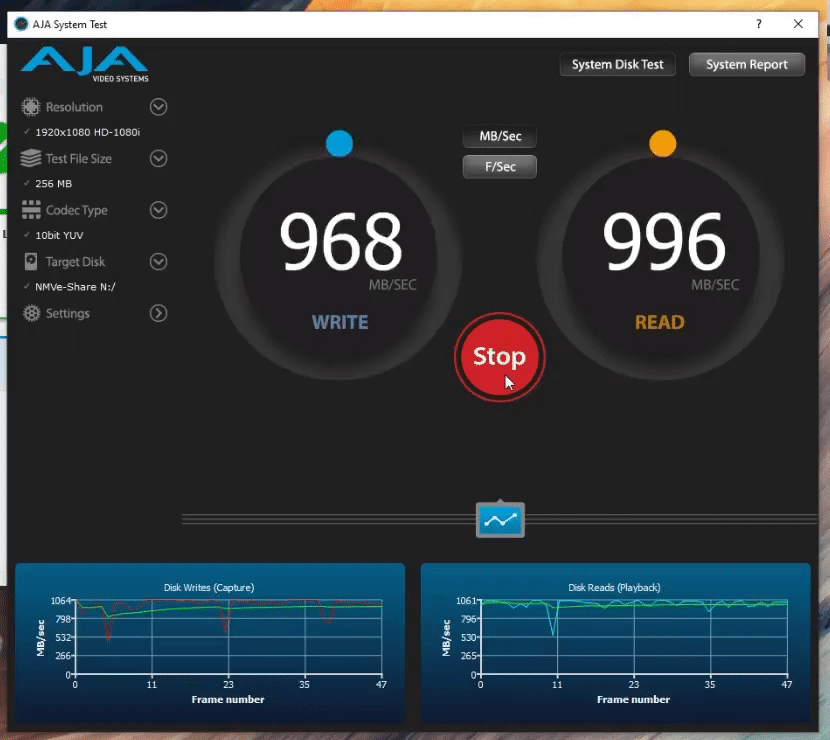
Internal vs External SSD Performance on M.2 NVMe SSD Storage Pools
Before we head into the DS923+ 10G and M.2 NVMe Test setup, there are a few very important things we need to highlight. The first is that we are measuring the EXTERNAL performance of these drives over 10GbE. As you might already be thinking, that means that the results cannot effectively exceed 1GB (1,000NB/s+), as this is the bandwidth of a single 10GBASE-T connection. This is true and I AM working on internal performance benchmarks using the NAS for internal stats. However, these take much more time, and require alot more setup and therefore I wanted to get the external testing out the way first. Regardless of the write/read speed of the drives in the system, external 10G performance is still valid in the case of single and/or RAID’d drives, as I will be covering several different file sizes (starting at 64MB and ending at 16GB), which will show us the benefits of these drives, their reported IOPS vs Throughput and in the case of tests that repeat (AJA for example above) it will show how the M.2 NVMe SSD Pool dealt with over-saturation.
NVMe Compatibility on the DS923+ NAS as Storage Pools
Next, the subject of M.2 NVMe SSD compatibility on the DS923+ NAS for storage pools. At the time of writing (and after testing 10 other SSDs, including WD Black, Seagate Firecuda and Sabrent Rocket drives), you can ONLY use the Synology range of SSDs for M.2 NVMe SSD storage Pools (so, SNV-3400, SNV3410 and SNV3500). Hopefully this feature, as time wears on, will be opened up to support more M.2 NVMe SSDs, but as it stands right now, you can only use Synology drives. Aside from the question of limited support towards only 1st party drives (always unpopular), the SNV3400 and SNV3500 series have notably low Seq Write speeds (capping at around 800-1000MB/s depending on the capacity). Read speeds are the expected PCIe3 3,000MB/s though. This does mean that write performance in these tests, regardless of internal or external performance, is going to be pretty underwhelming. As mentioned, hopefully, Synology resolves this by producing faster 1st party m.2 NVMe SSDs or opens up the compatibility.
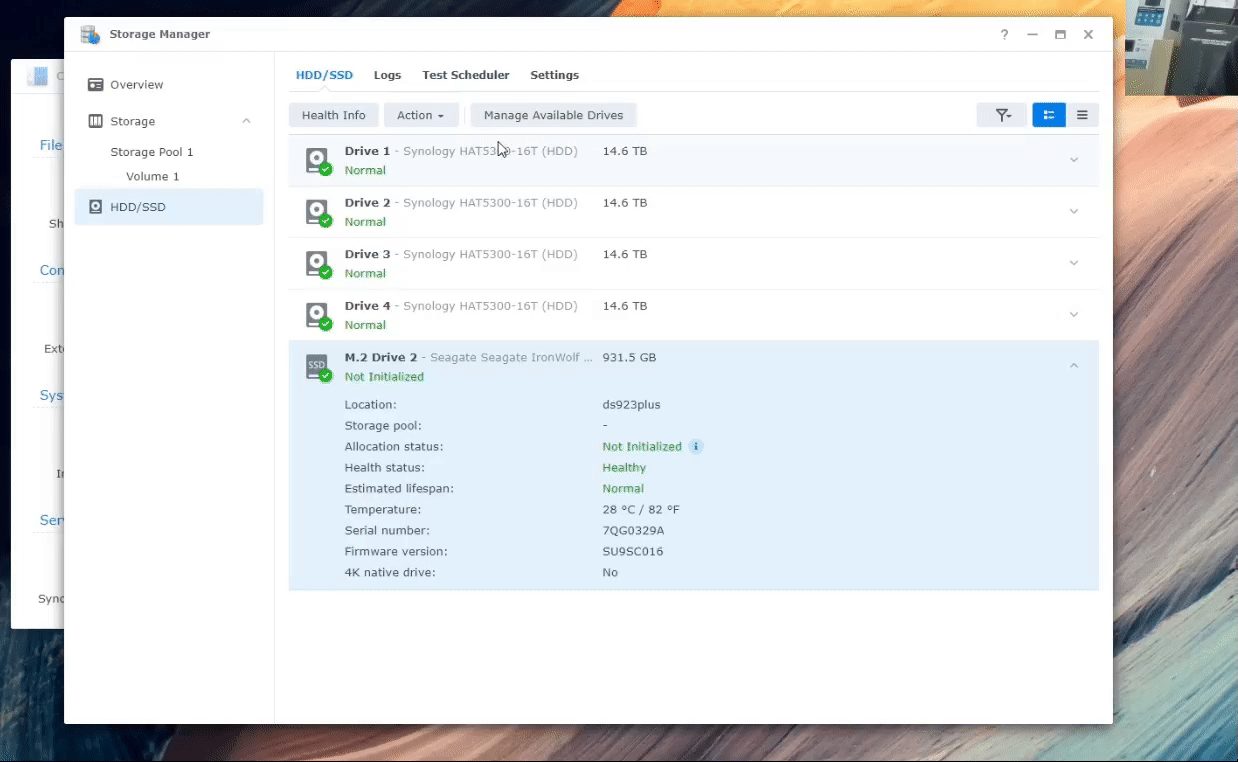
PCIe Architecture of the M.2 NVMe SSDs inside the DS923+ NAS
Last point is regarding the M.2 NVMe SSD architecture of the DS923+ NAS. At the time of writing, this is still being further dug into, but it would appear that the M.2 NVMe SSD slots of the DS923+ NAS are capped at PCIe Gen 3 x1, despite being PCIe Gen 3×4 DESIGN. Now, whether this is because Synology is using many of the NAS Chipset/lanes towards other hardware components of the system, or this is something that will get opened up later, remains to be seen. But at PCIe Gen 3 x1, that means these bays are going to hit a wall at the 1GB mark. Again, this is something I will be fully investigated with Eddie before pursuing our internal DS923+ NAS tests but still needed to be highlighted here.
Synology M.2 NVMe SSD Storage Pools – Test Setup
So, the tests! The first thing I need to establish is the setup of the M.2 NVMes in each of the tests. Throughout these tests, the DS923+ NAS was populated with 4x HAT5300-16T 16TB hard drives and 2x M.2 NVMe SNV3400-400G SSDs. Now, the HDDs are NOT used in the tests (they are just present generally and DSM is running from them, you cannot boot DSM from the M.2 NVMes – see here about 2/3 down in the article) and at each of the test scenario, I will be using the same setup of Shared Folder, Volume Number at full available capacity and testing over direct point-to-point 10GbE connectivity via a windows PC, the Sonnet Solo 10G thunderbolt-to-10G adapter and the Synology E10G22-T1-mini upgrade.
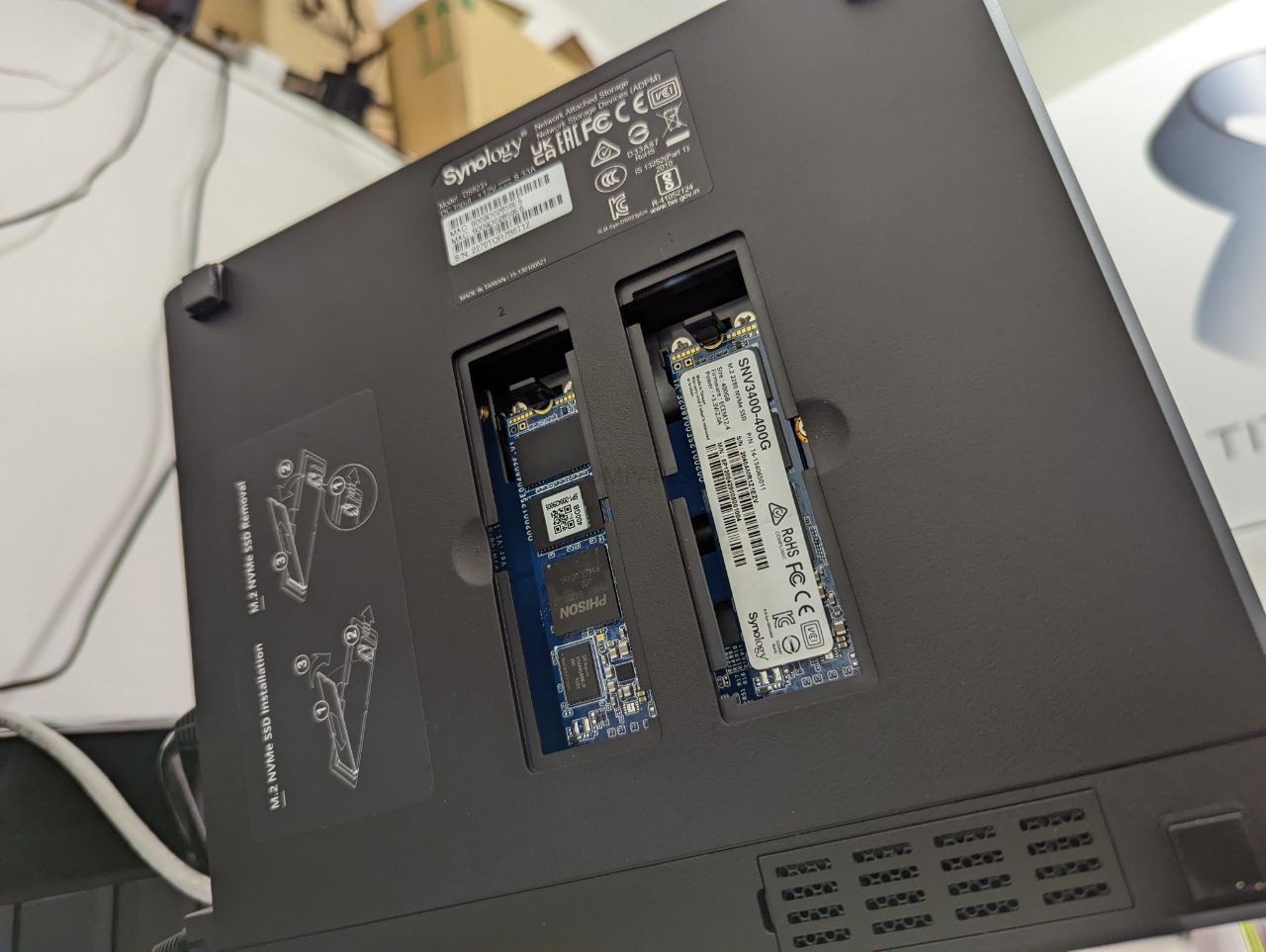
As you can see in the image below, I have installed 2x m.2 NVMe SSDs and run the performance tests using the Synology Storage Manager Benchmark tool. Depending on the test setup, it will either be 1 or 2 SSDs initialization and placed in a RAID group.
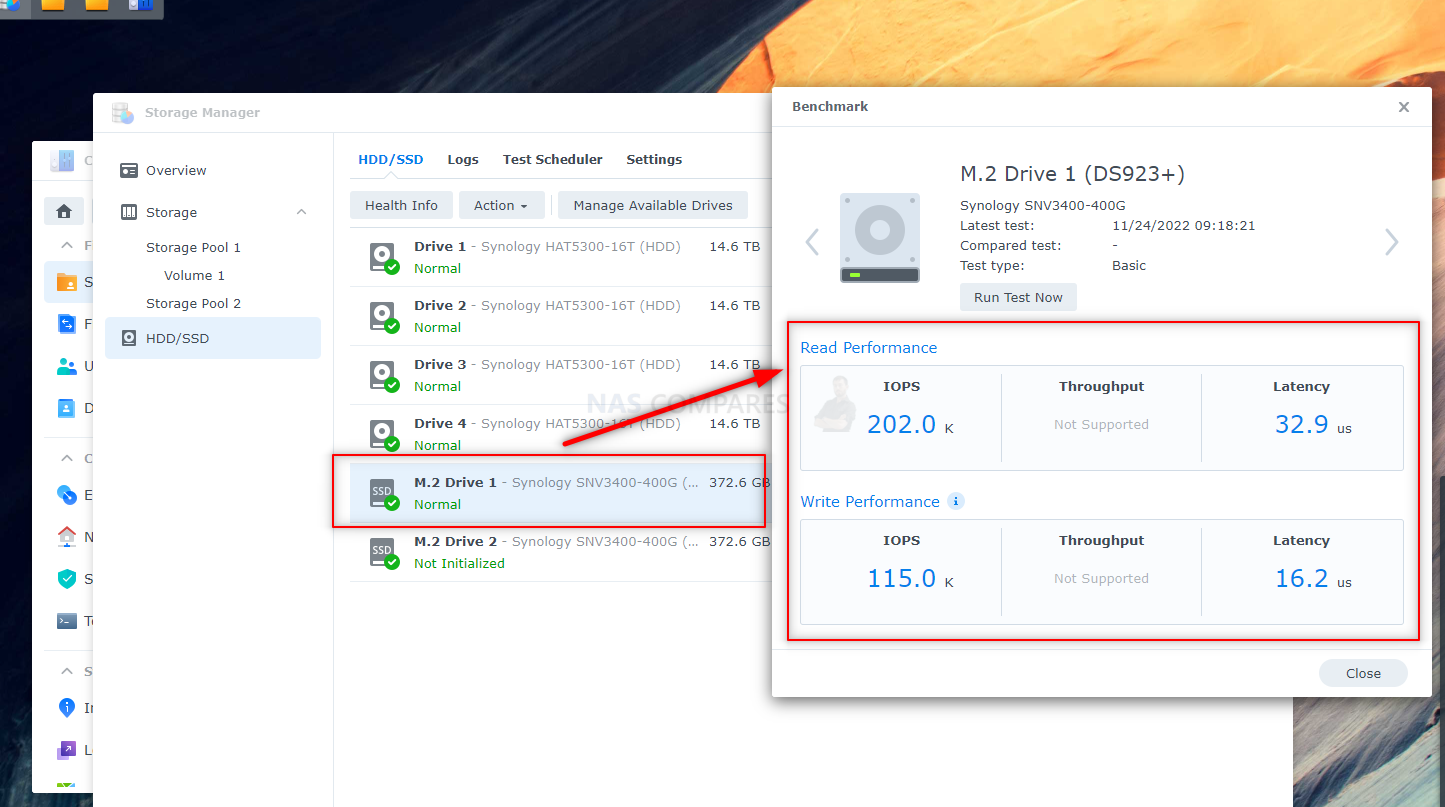
The network setup was conducted with the DS923+ NAS having the E10G20-T1-mini network adapter installed, a direct NAS-to-PC connection being established (no network switch) and the MTU/Jumbo frames at either end being set to 9K. The storage of the Synology NAS we are going to target is a shared folder, connected as a mapped network drive via windows SMB. On each test, the shared folder was re-created and always pointed at the relevant volume for the test.
For the PC to NAS connection over 10Gb, I used the Sonnet Solo 10G to Thunderbolt 3 Adapter. I did this out of convenience, but even a low-level 10G unmanaged switch-based 1-to-1 connection should achieve the same results.
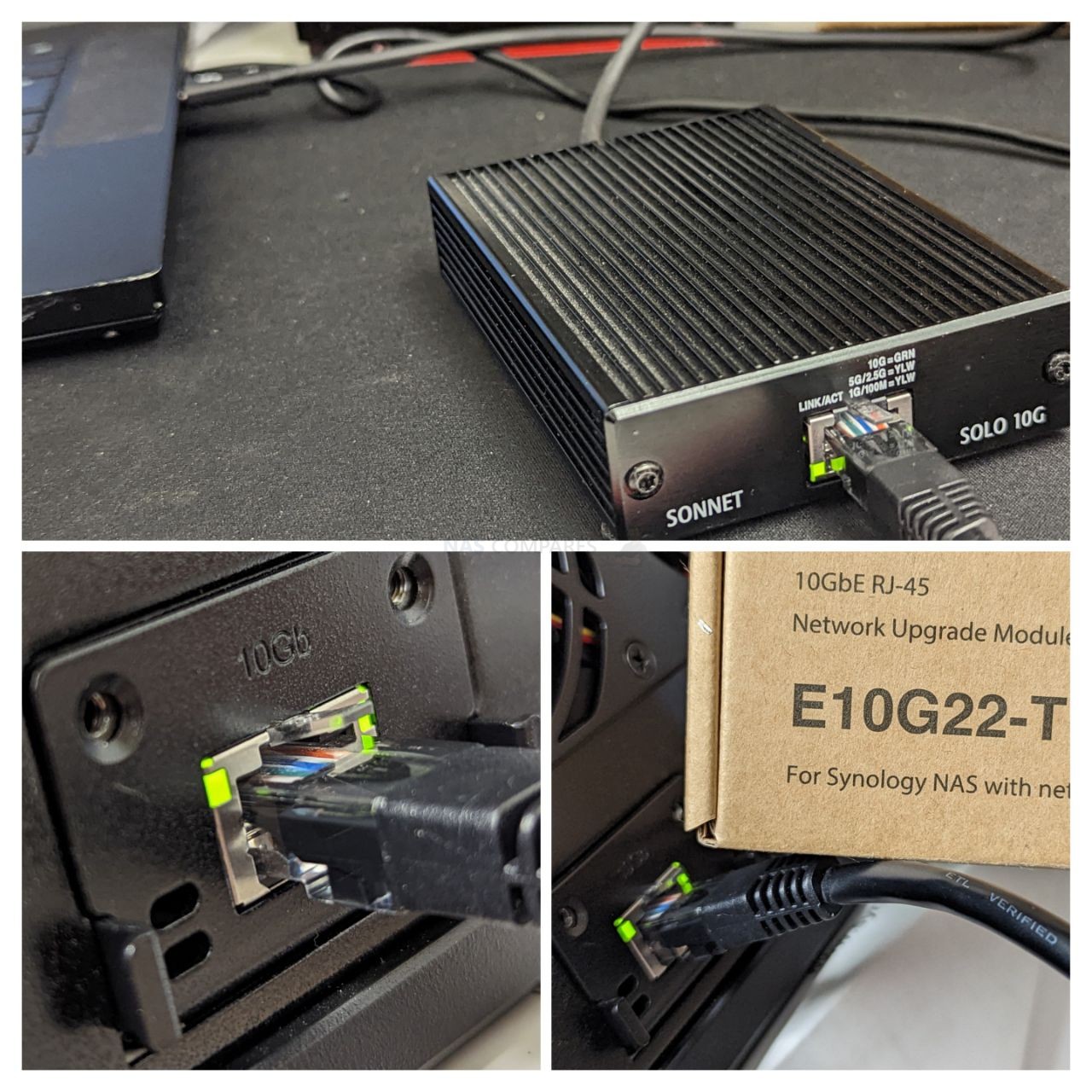
So, that is how my tests were set up (with each change in RAID/Pool resulting in the tests being rebuilt each time). Let’s go through how each RAID/Profile of M.2 NVMe SSDs in the DS923+ Performed.
| Hardware I used in this test and where to buy it:
Synology DS923+ NAS – HERE on Amazon Synology E10G22-T1-MINI Network Adapter – HERE on Amazon Synology SNV3400-400G M.2 NVMes – HERE on Amazon Sonnet Solo 10G 10GbE to Thunderbolt 3 Adapter – HERE on Amazon |
Test Scenario 1 – 1x SNV3400-400G M.2 NVMe SSD Storage Pool (no RAID)
So, test one was the SINGLE test. This was just one Synology M.2 NVMe SNV3400-400G being used to create a Storage Pool, then a Max size volume was created, followed finally by a shared drive (no storage quota/limit) on that volume that was connected to the Windows PC as a mapped network drive. I did consider using a targetted LUN via a 10GbE mounted/connected target (as used in my original coverage on this subject on YouTube in Nov ’22), but the range of changes that would be made throughout the different scenarios made this overly complex and (at least as far as 10Gb and these drives over NVMe speeds would dictate) a Mapped Network Drive is more than sufficient.
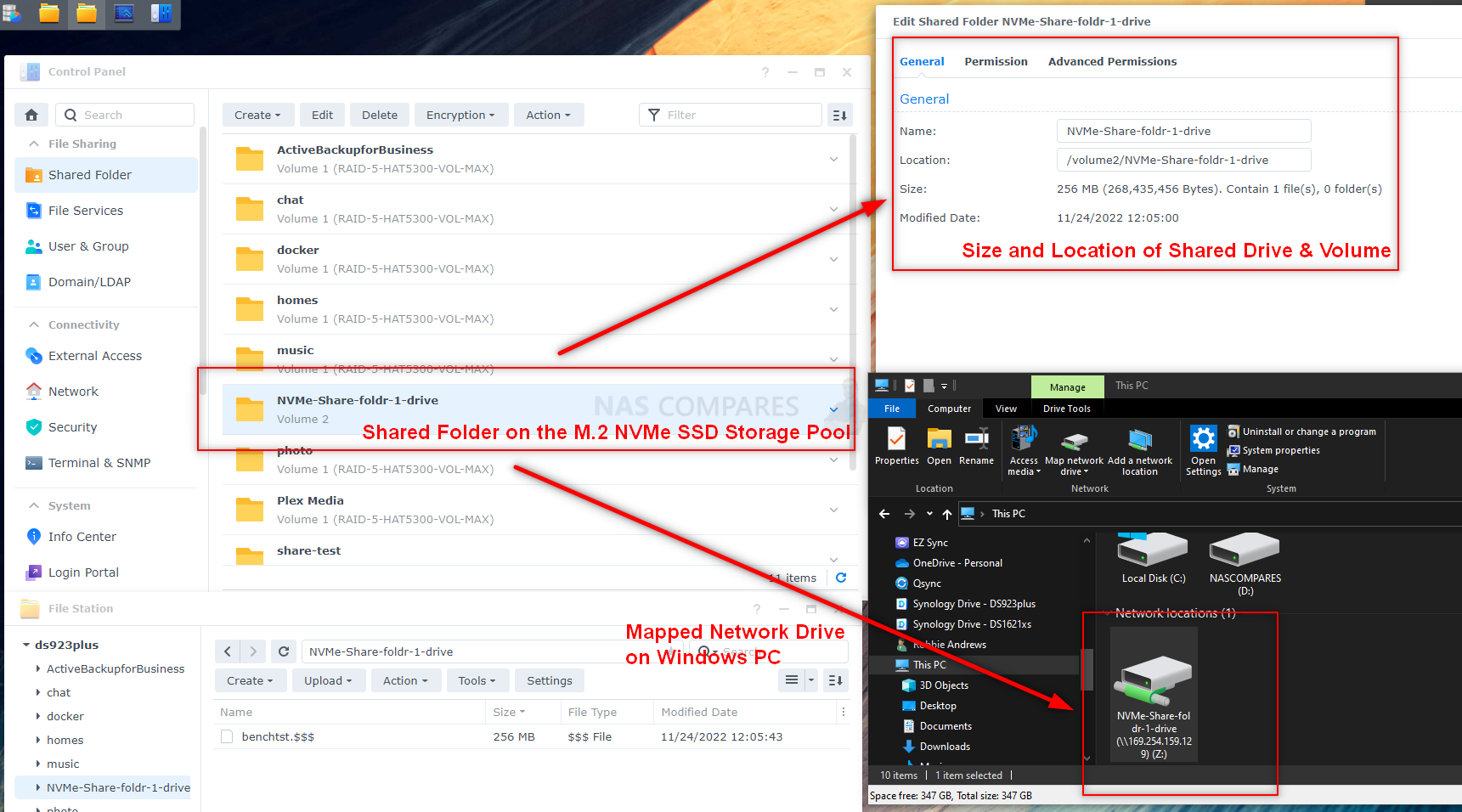
Atto Disk Benchmark, 1x SNV3400-400G M.2 NVMe SSD Storage Pool Tests
Atto was the first test. I conducted five different file size profiles at 64MB, 256MB, 1GB, 4GB and 16GB. It is worth highlighting that the 10GbE connection in these tests is only really going to show meaningful strain when the file size exceeds 1GB/1000MB, HOWEVER it is more important that we observe the repeat transfers in relation to the I/O sizes, as the weight of these files and how the SSD performance vs DS923+ system hardware can repeatedly deliver the growing file is what we want to measure. additionally, I have included the IOPS-I/Os at each scaled file. Now, these are not really indicative of the drives (as most random IOPS ratings are publicized at 4k), but I include them more for the smaller profile tests. Here are the results:
64MB File Size
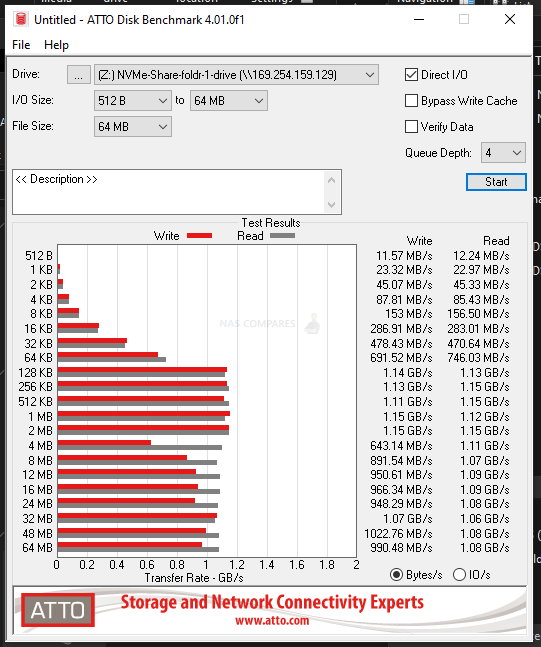 |
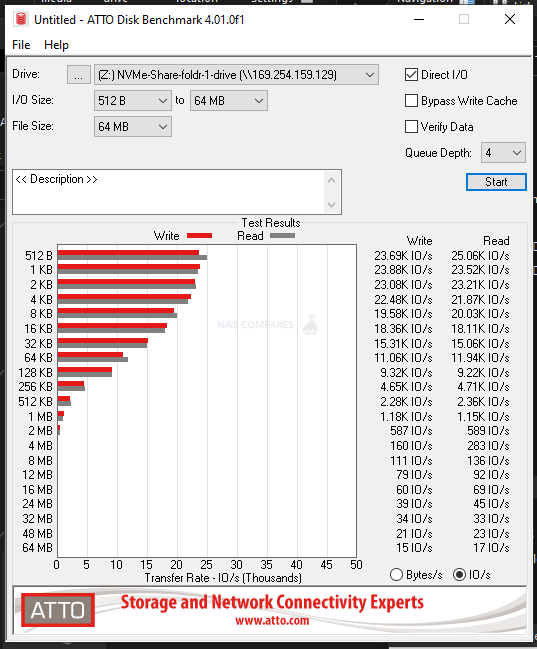 |
256MB File Size
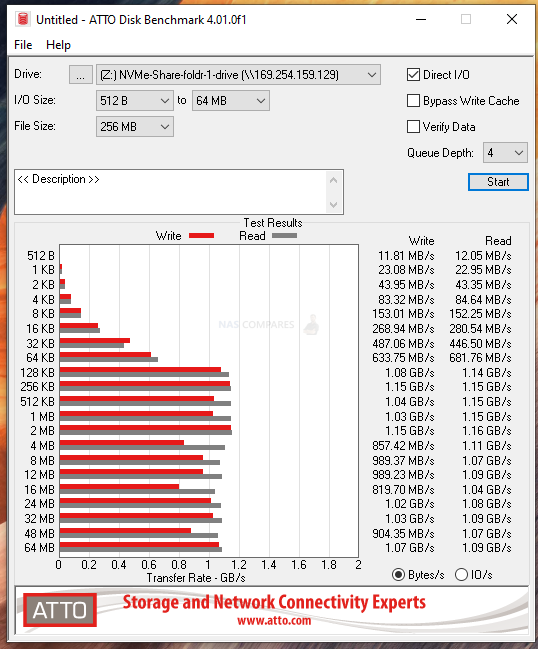 |
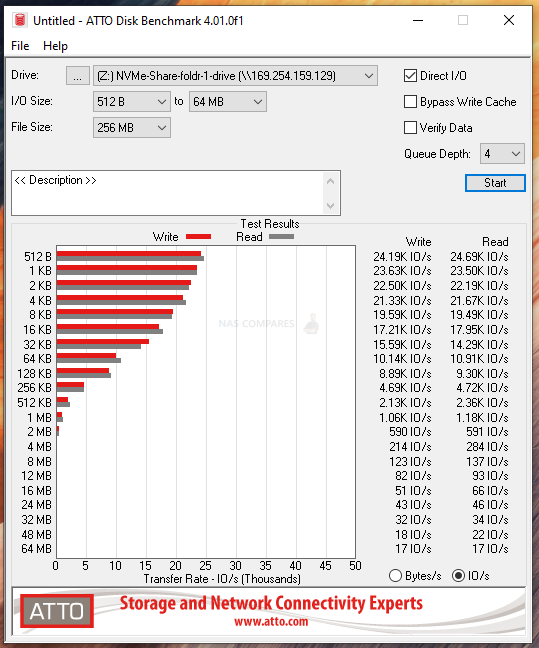 |
1GB File Size
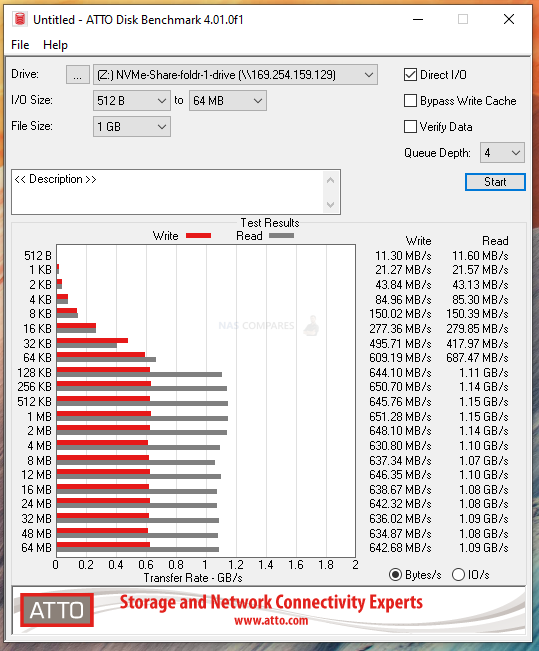 |
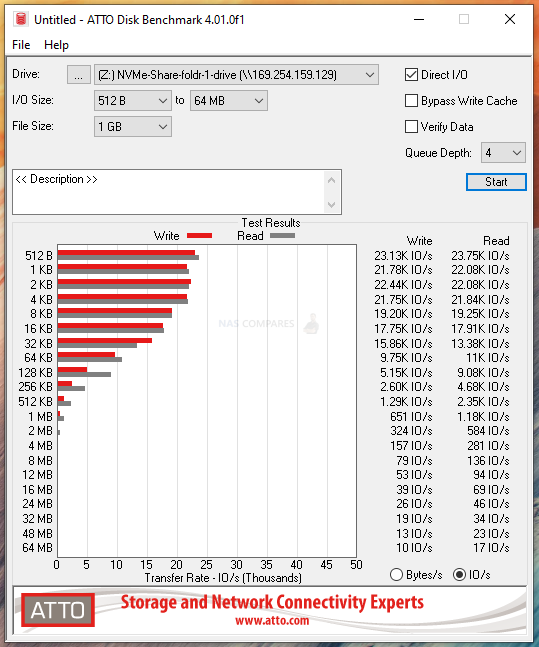 |
4GB File Size
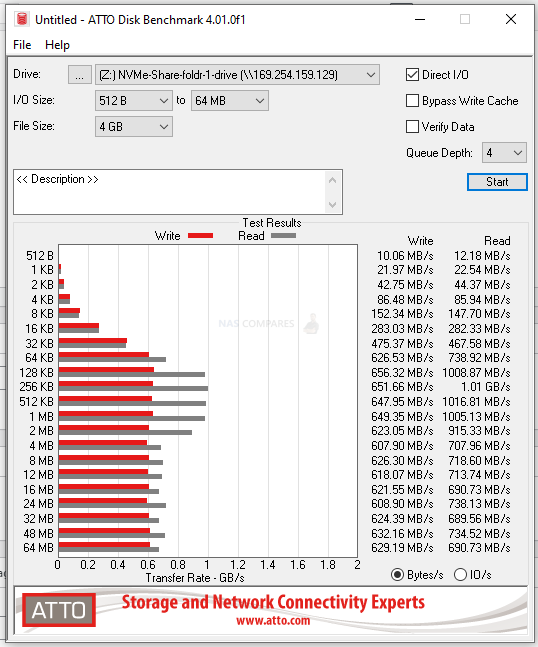 |
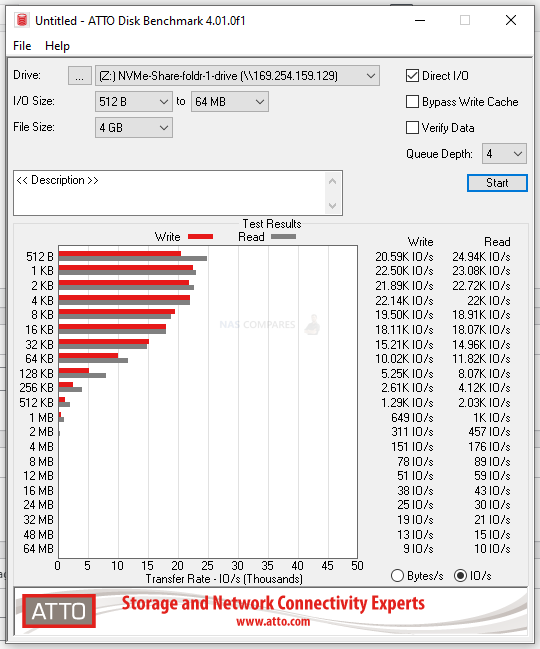 |
16GB File Size
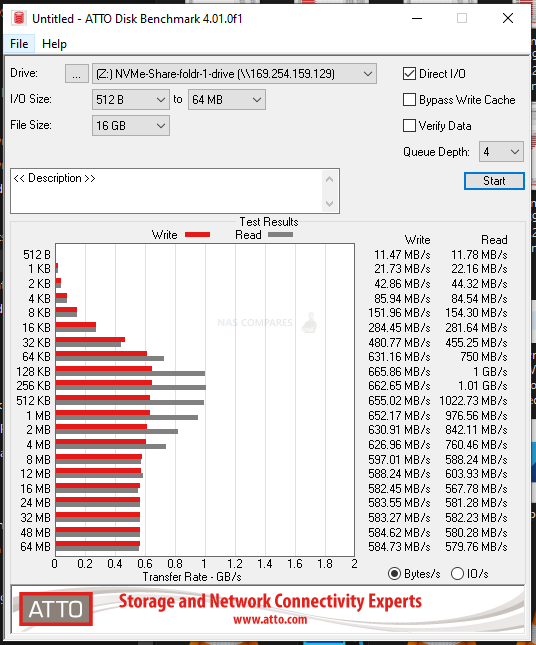 |
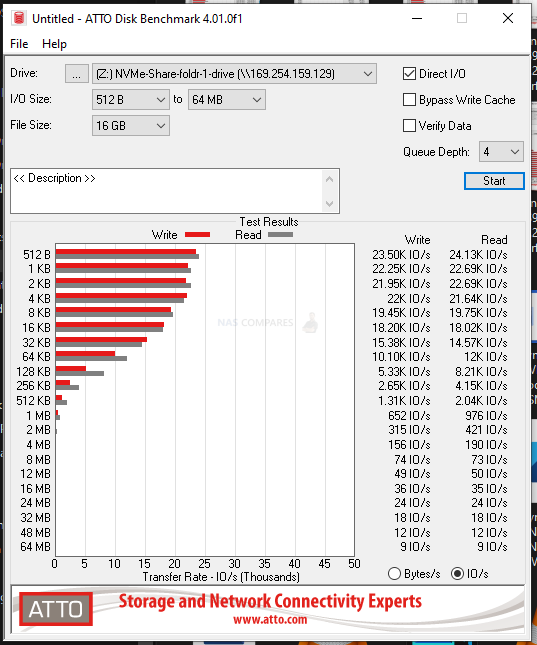 |
So, as you can see,full network saturation was achieved in all the 1GB and under tests consistently in Seq Read, though the reported low write speed of the Synology M.2 NVMe SSD bays was pretty clearly down to the SNV3400-400G arriving with that low reported write speed to begin with. In the greater than 1GB testing, that is when we saw the Seq Read begin to buckle a little. Still, to still maintain a 500-600MB/s benchmark at the 16GB (as well as hit 700-1000MB several times at the 4GB level) was still very good. Let’s move on to the AJA tests
AJA Speed Test 1080i, 1x SNV3400-400G M.2 NVMe SSD Storage Pool Tests
AJA testing was conducted on 4 different file sizes (256MB, 1GB, 4GB and 16GB) of a 1080I HD test file. Only a single cycle was performed, so over saturation of the SSD cache/controller is not a factor (as well as no slow spin up that you would need to factor in a HDD array). Here is how those tests went:
256MB File Size
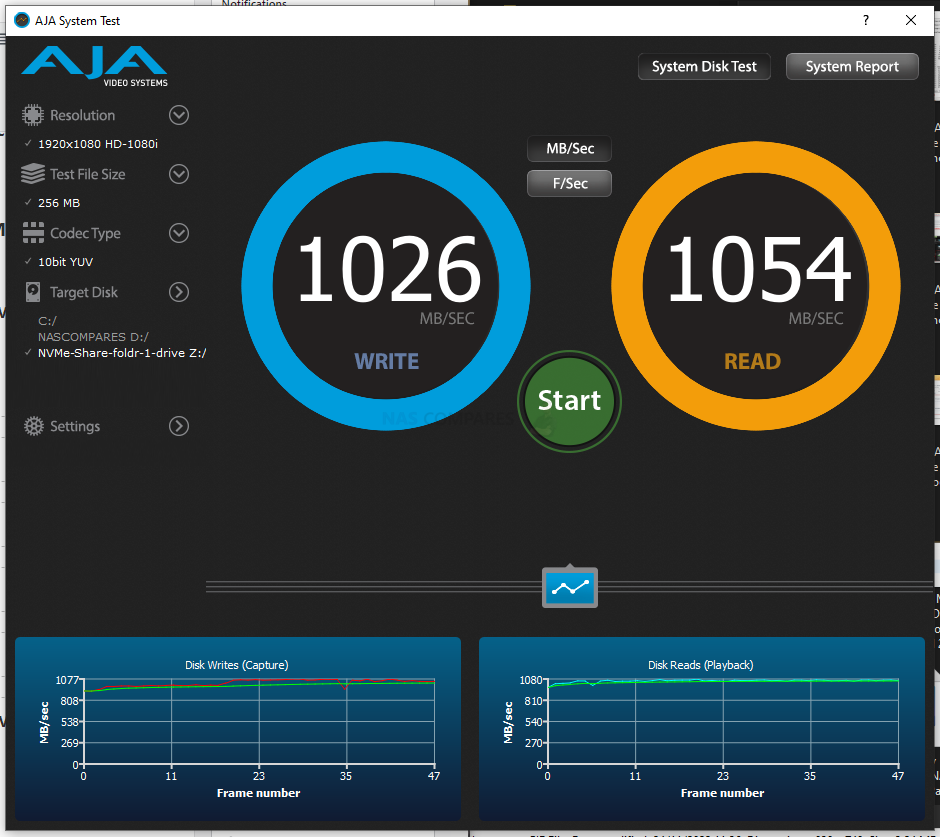
1GB File Size
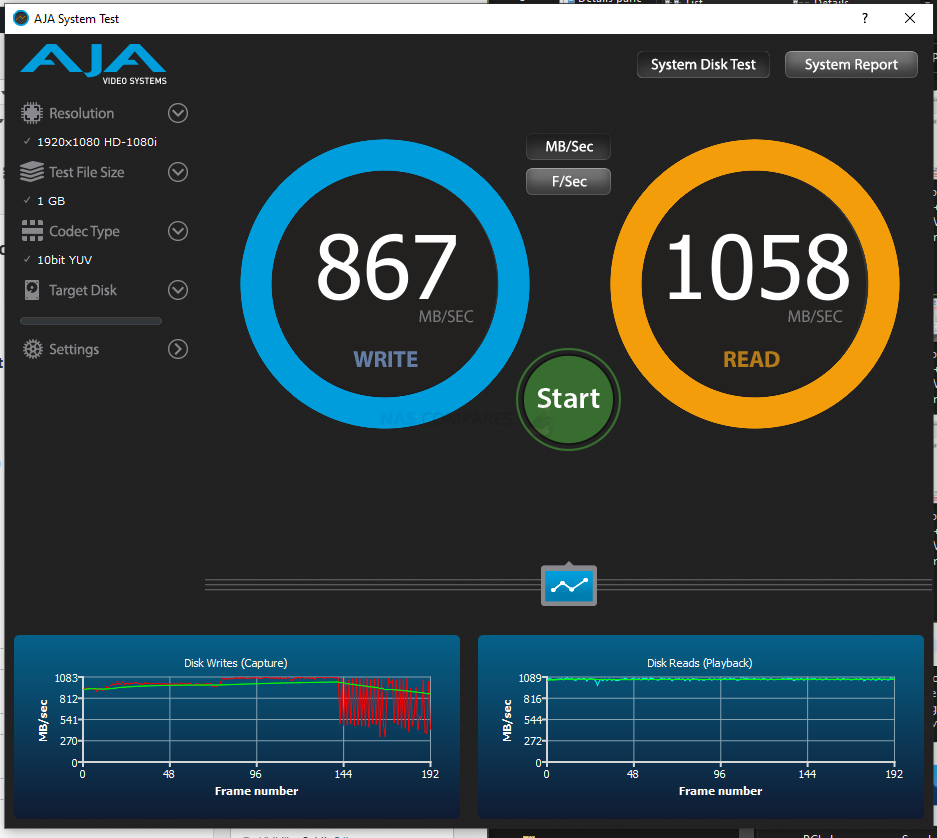
4GB File Size
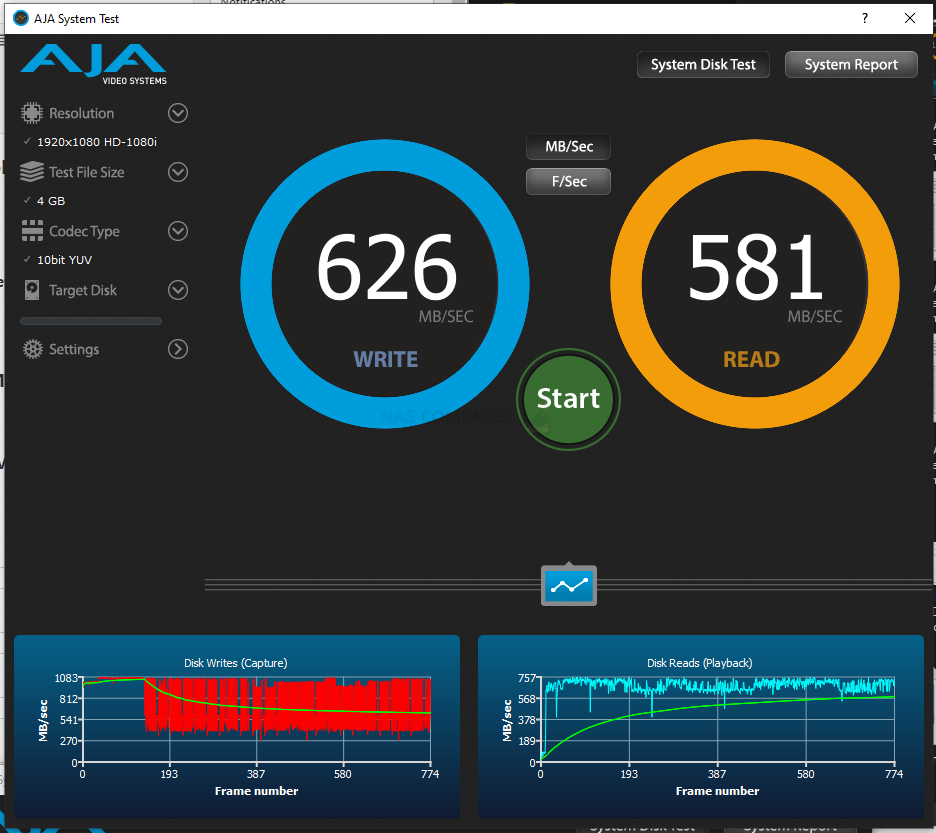
16GB File Size
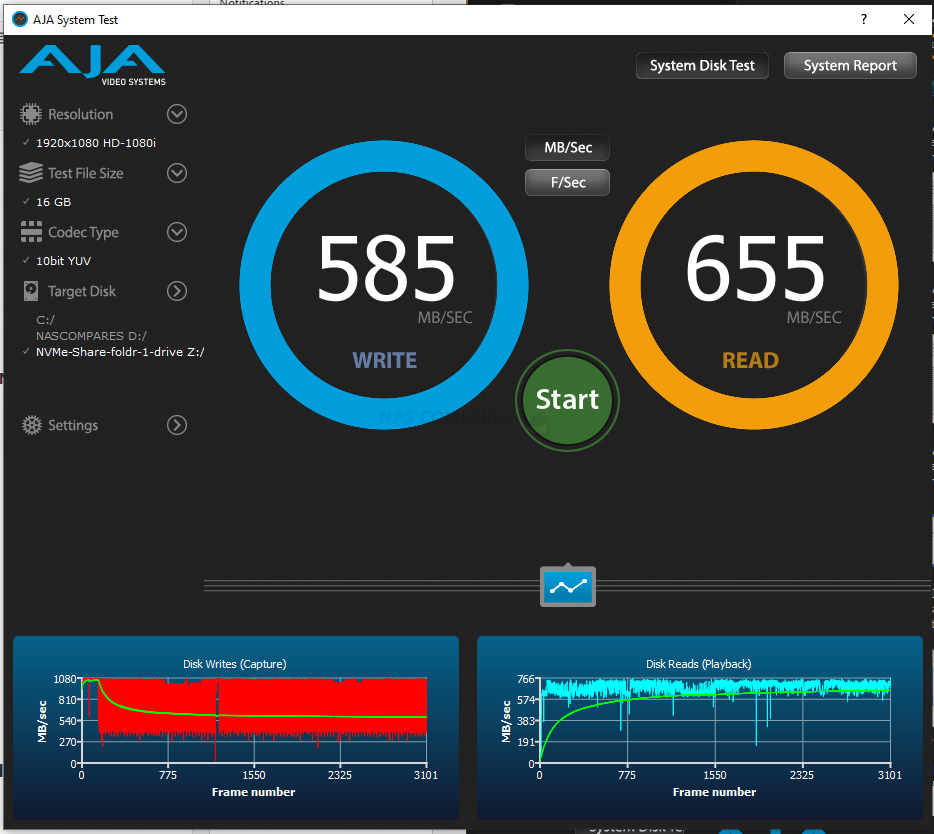
Once again, we saw very similar results to those of the ATTO Disk Benchmark tests, as well as having the graphs at the foot of each test image to show how consistent the read/writ was against the result (i.e avg).
Black Magic Speed Test, 1x SNV3400-400G M.2 NVMe SSD Storage Pool Tests
Finally, we went with three tests using Blackmagic Disk Speed Test at 1GB, 3GB and 5GB. For those considering the DS923+ NAS and it’s M.2 NVMe SSD Bays for video editing over 10Gb, these tests will give you a pinch more insight:
1GB File Size
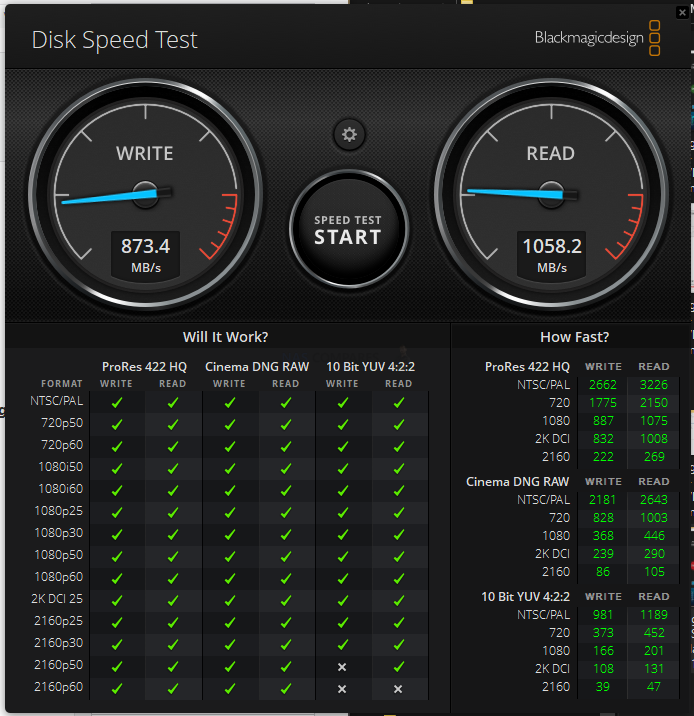
3GB File Size
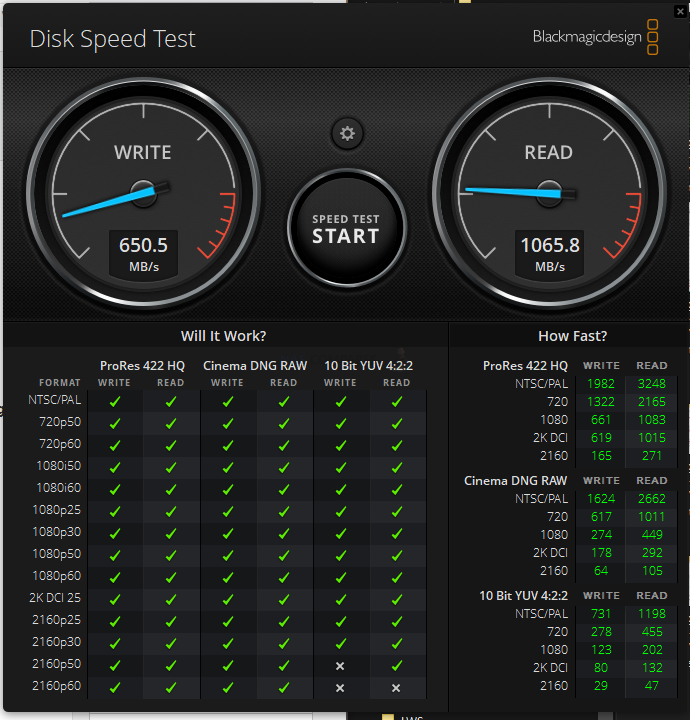
5GB File Size
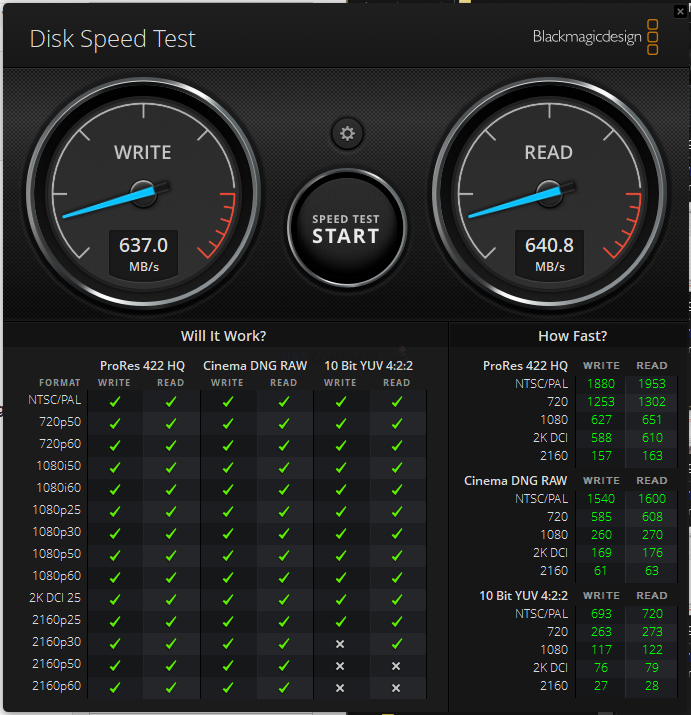
Overall, throughout all of these tests, Seq Read speeds were consistently high and were fully saturating the 10G in files tests upto about 3-4GB for the most part (unsurprisingly). However, that write performance of a single SSD on the already low official benchmark SNV3400-400G really showed that you are simply not going to max out a 10Gb connection with a single drive, even in the smallest 64MB file test. Let’s move onto the first of our RAID tests.
Test Scenario 2 – 2x SNV3400-400G M.2 NVMe SSD Storage Pool in RAID 0
We repeated the exact same setup in our tests, but this time we are using TWO of the SNV3400-400G SSDs in a RAID 0 (combining their capacity, but with no redundancy – so lost a drive, lose the RAID!). This means that in our testing we will effectively have two drives being read/written too and although we likely won’t see the benefits in Read speed until we exceed the 1GB mark, the seq Write speed will hopefully see improvements against the 1x drive tests in the DS923+.
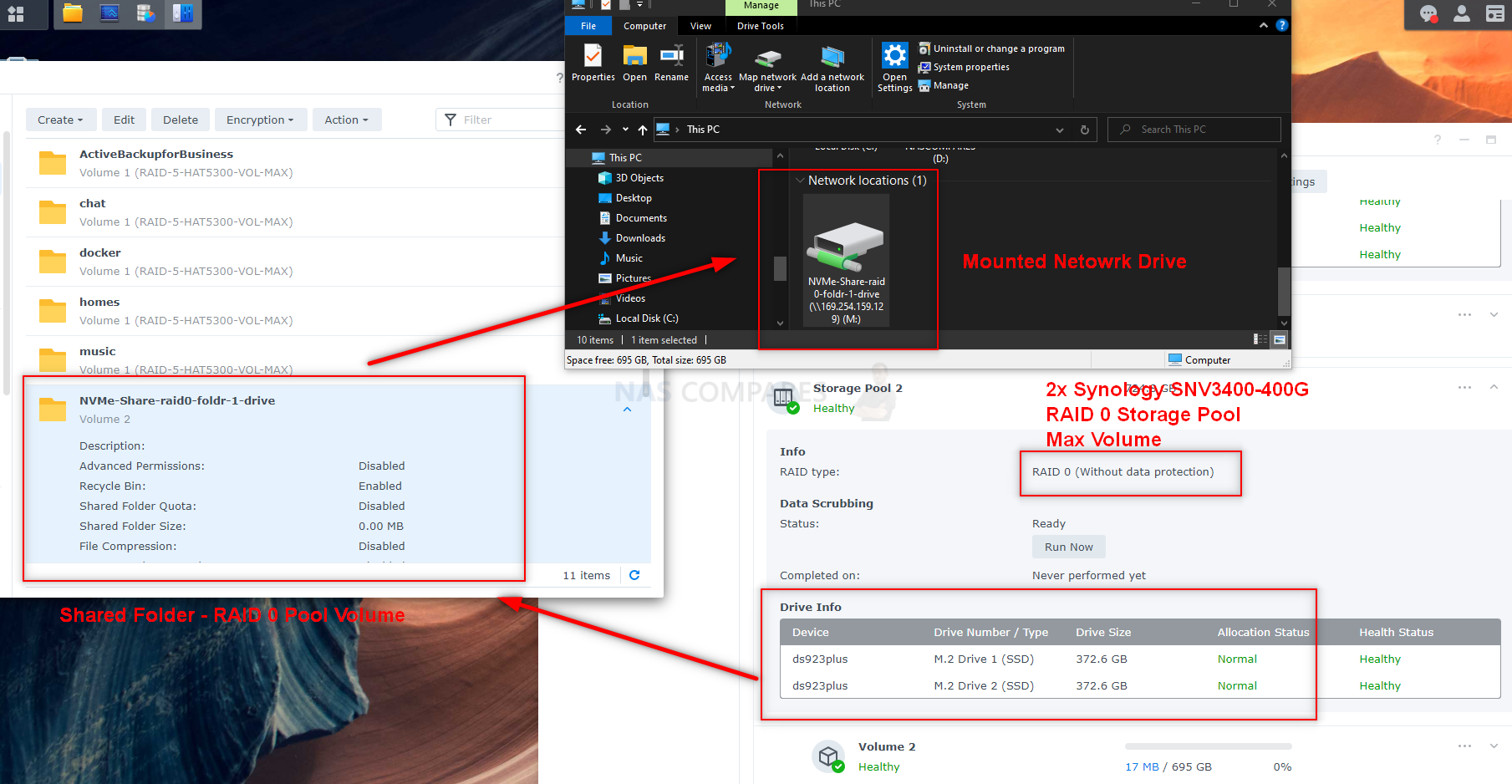
Atto Disk Benchmark, 2x SNV3400-400G M.2 NVMe SSD RAID 0 Storage Pool Tests
So, ATTO tests first and this time we saw the 1GB/1,000MBs mark get hit ALOT more on both the Read and Write. Things are particularly worth noting at these larger capacities:
64MB File Size
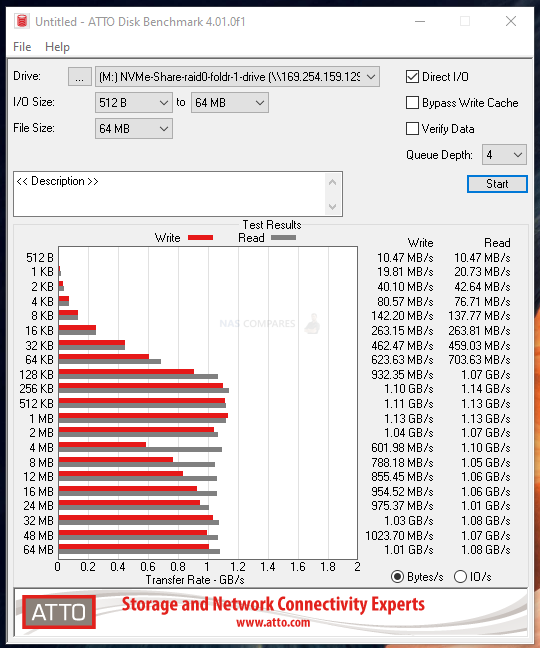 |
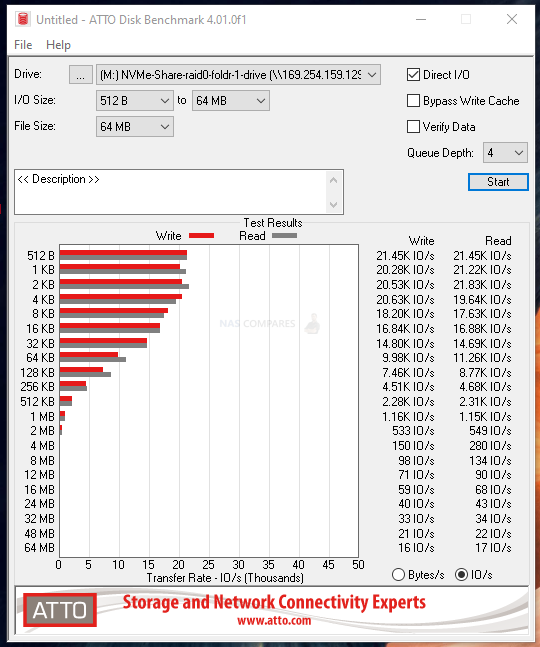 |
256MB File Size
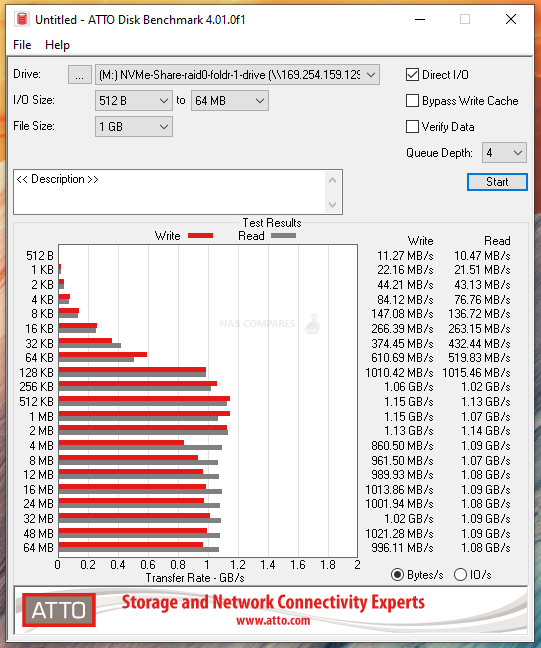 |
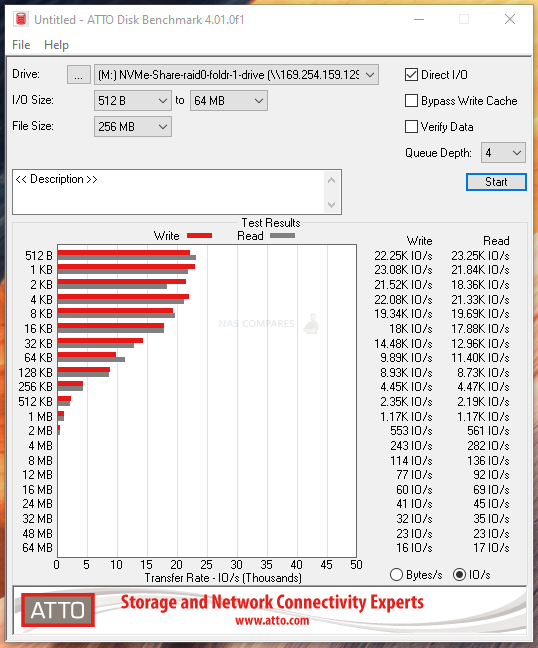 |
1GB File Size
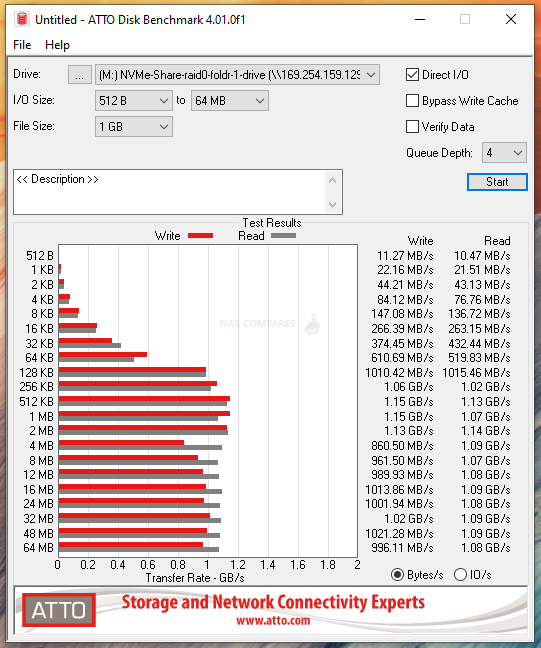 |
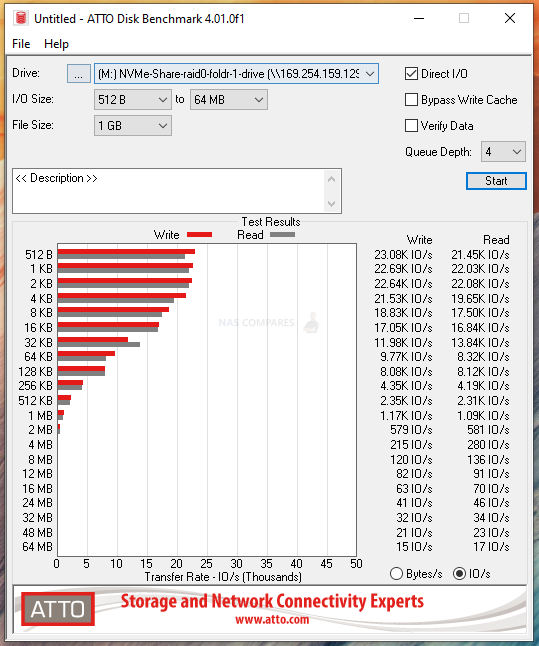 |
4GB File Size
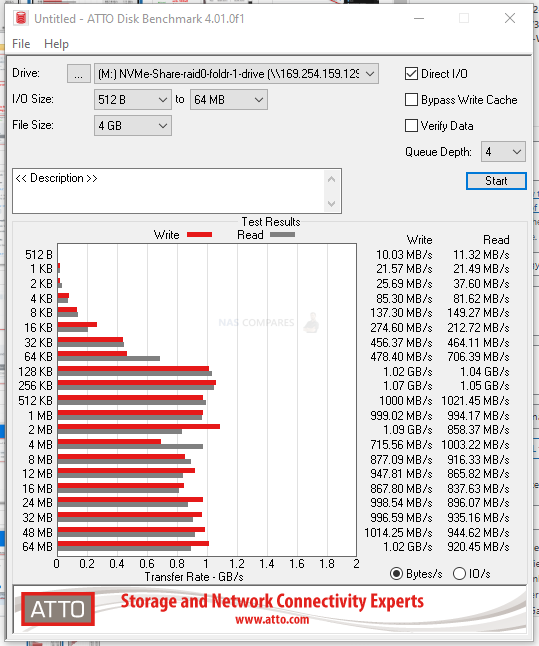 |
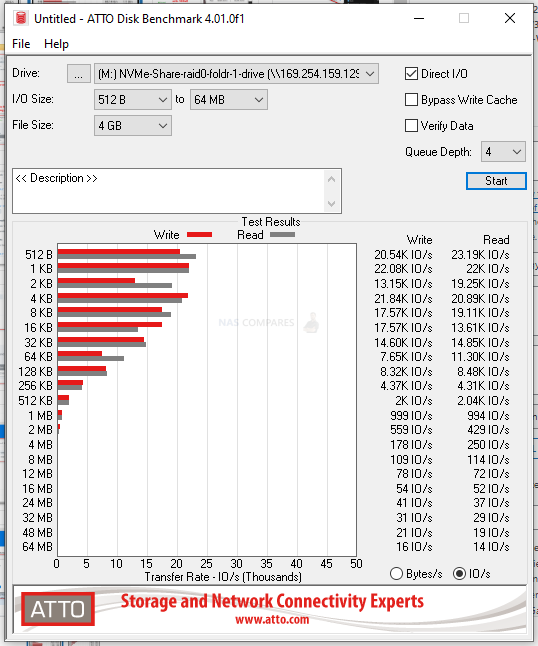 |
16GB File Size
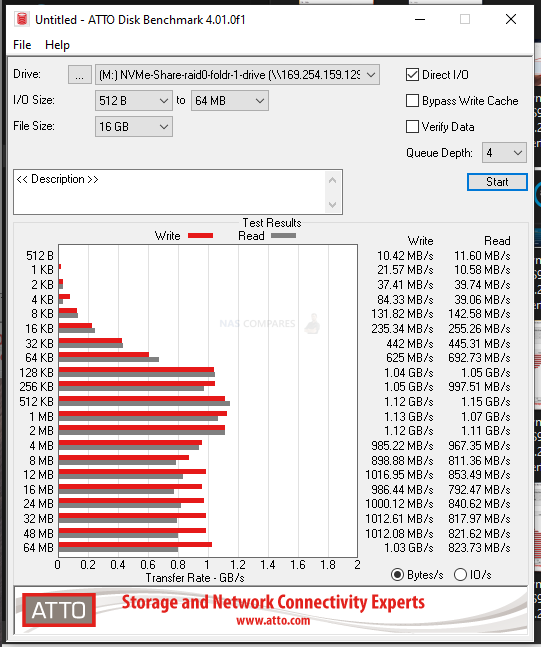 |
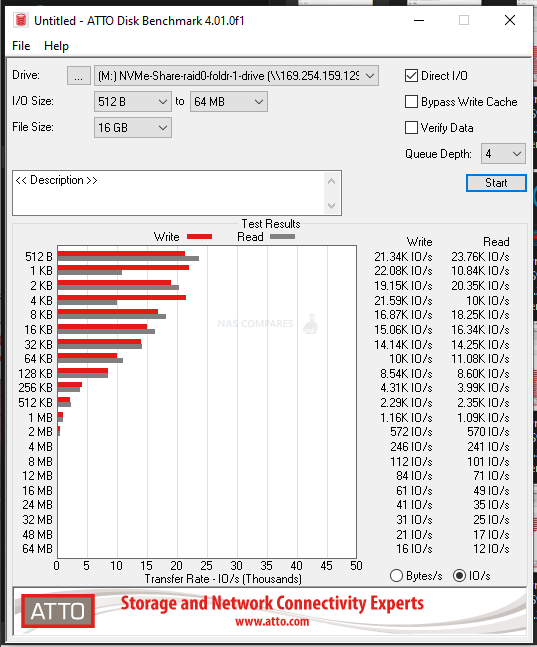 |
Even when we were hitting the 4GB and 16GB test will, we saw write speed hitting 1GB/1000MB/s, thanks to the 2-drive access on the RAID 0. Additionally, even the seq read speeds 250-400MB/s higher this time. As good as this sounds though, you have to factor this against the lack of any redundancy and I would still highly recommend using the HDD array or even an off site system as a sync of these drives in the background to leverage a little against the lack of RAID safety net. Next, AJA testing!
AJA Speed Test 1080i, 2x SNV3400-400G M.2 NVMe SSD RAID 0 Storage Pool Tests
AJA tests in the 2x M.2 NVMes in a RAID 0 in the DS923+ was almost a complete clean sweep for full 10GbE saturation. Here is how it went down:
256MB File Size
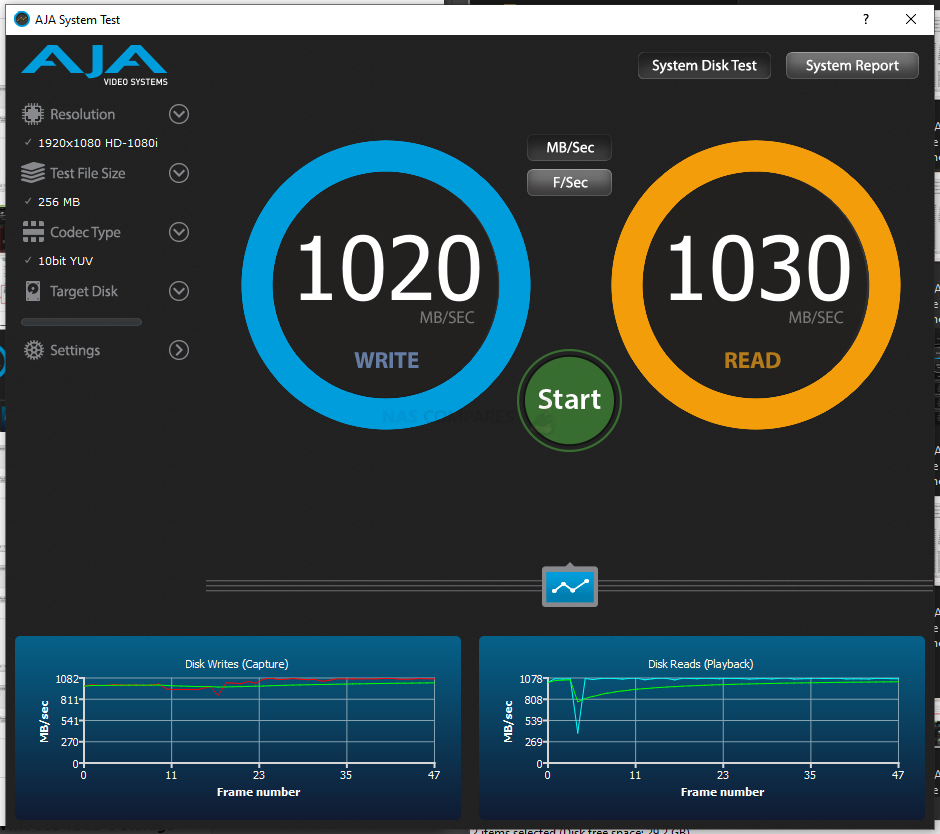
1GB File Size
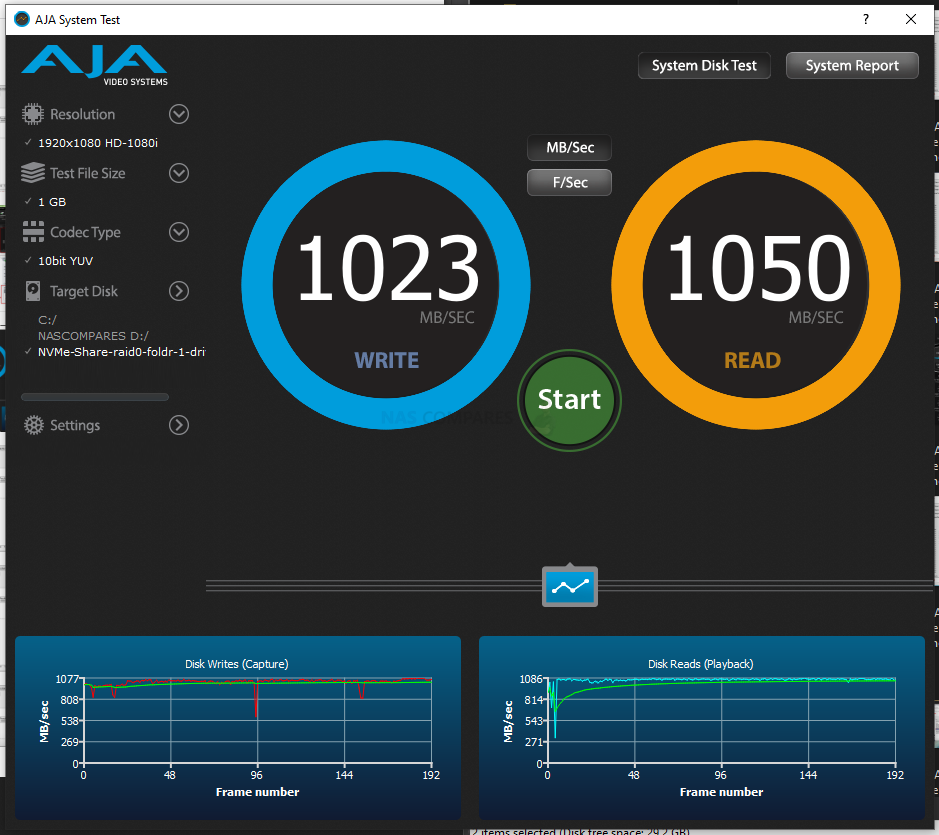
4GB File Size
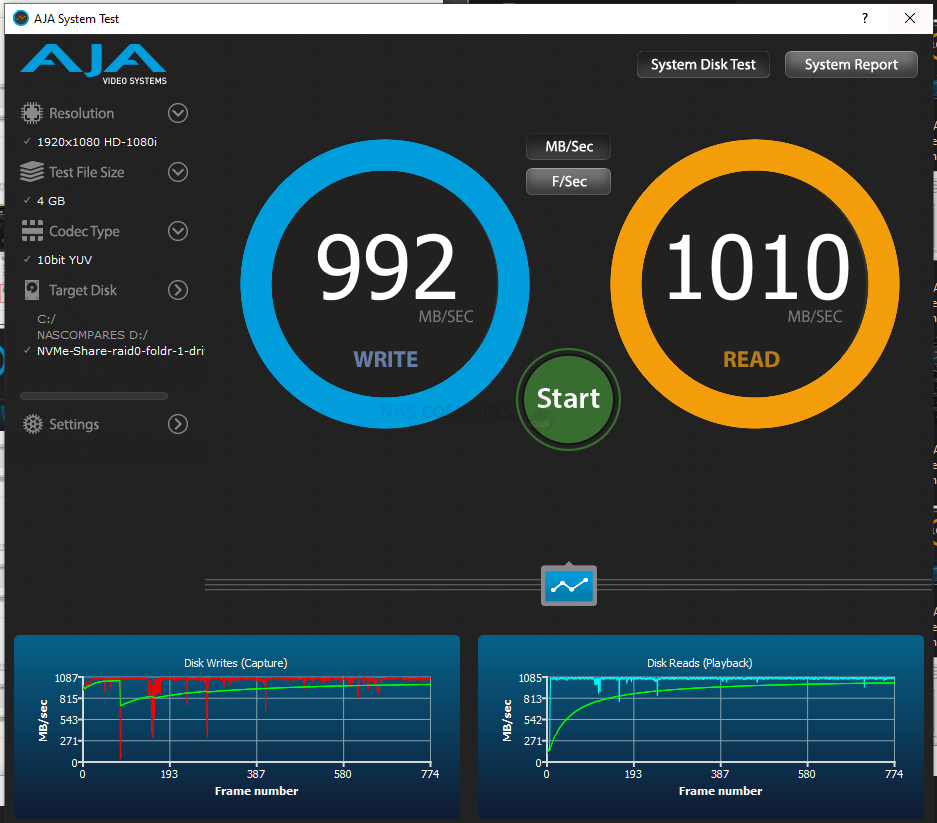
16GB File Size
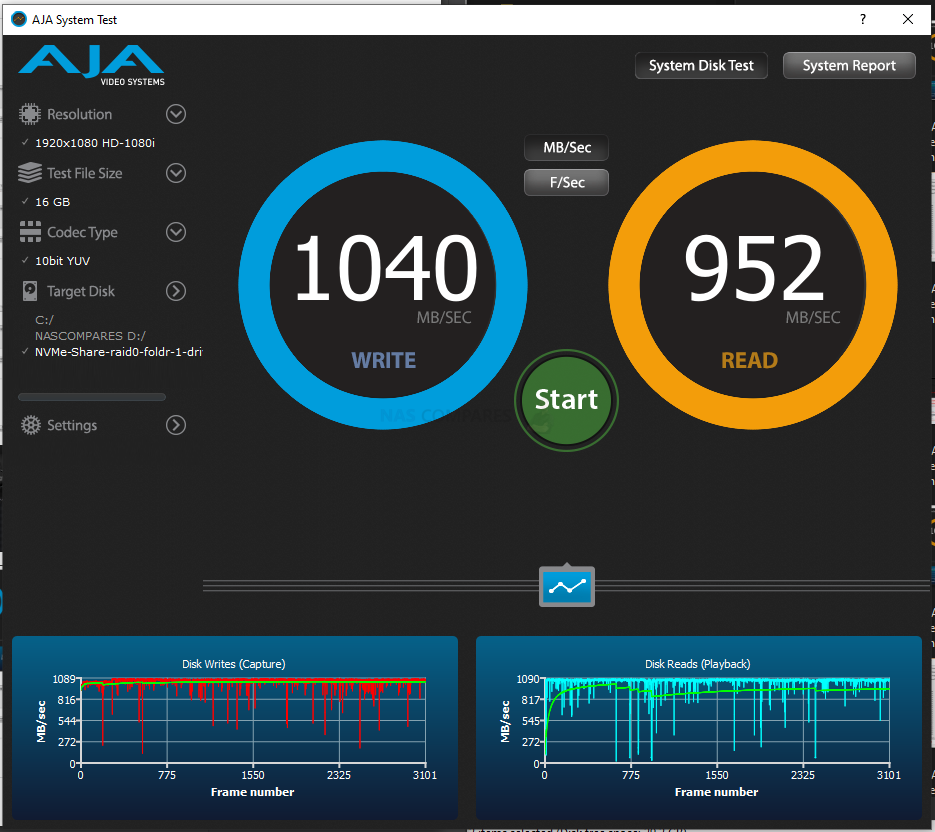
Looking closely at the graphs, you can see that even in the 16GB testing, the drops were few and far between, with the avg/medium being in the 900MB/s fairly constantly. Once again, RAID 0 advantages of performance are clearly available on these m.2 Bays and although the PCIe3 gen speed on these individual bays is still a little in question, the system is clearly running these into a wide enough bandwidth controller slot to take advantage.
Black Magic Speed Test, 2x SNV3400-400G M.2 NVMe SSD RAID 0 Storage Pool Tests
Finally, those Black Magic Speed tests and again, the RAID 0 of the M.2 NVMe SSD storage pool, regardless of the 1/3/5GB file size, hugely saturated the connection at all times:
1GB File Size
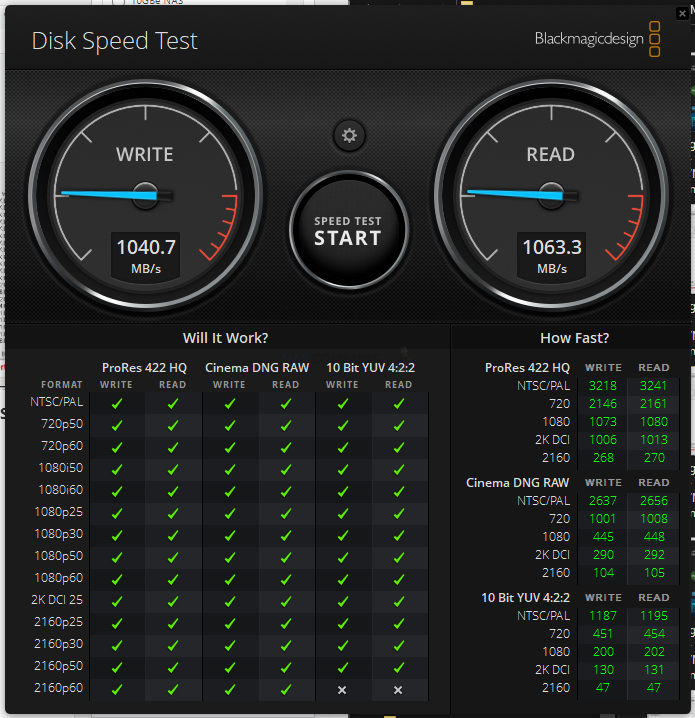
3GB File Size
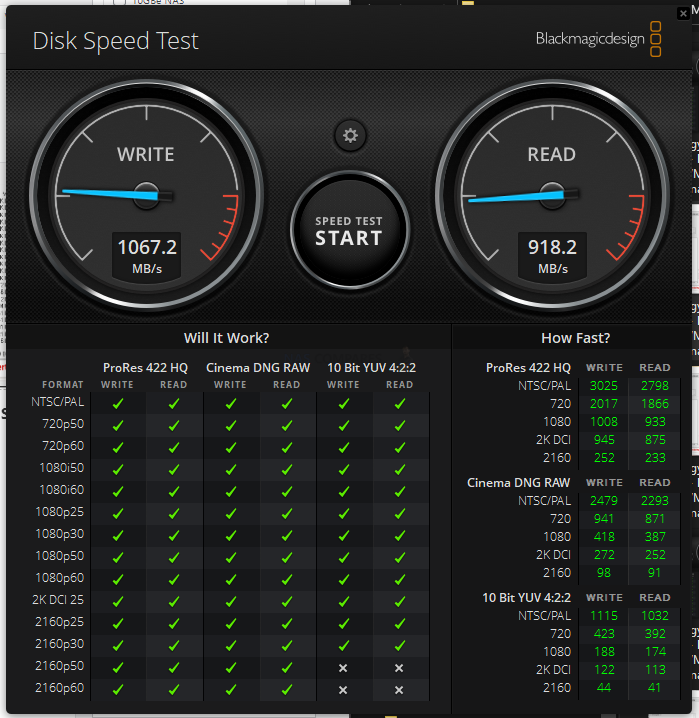
5GB File Size
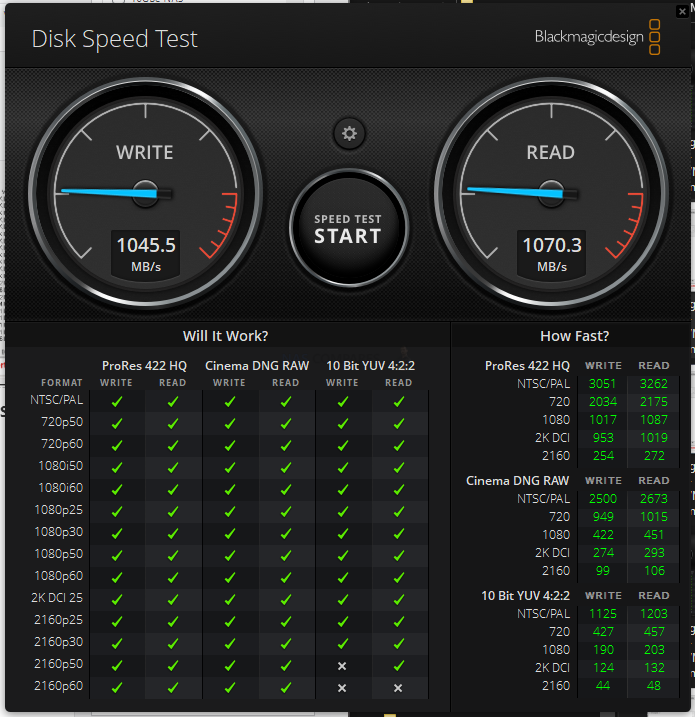
So, overall and unsurprisingly, we saw the 10GbE connection with two of these drives fully saturate the connection. However, we can not overlook that creating a RAID 0 to achieve this on the proprietary Synology SSDs (which relative to other PCIe3 NVMes from Samsung, WD and Seagate are lower in performance, yet higher in price) is going to need additional layers of protection/backup to compensate for the loss of redundancy. So, what about a RAID 1? Is that going to give us even a pinch better results than the SINGLE or RAID 0? Is the loss of 50% of possible capacity going to be made up for by the performance? Lets see.
Test Scenario 3 – 2x SNV3400-400G M.2 NVMe SSD Storage Pool in RAID 1
Once again, we rebuild the test, this time with the 2x Synology SNV3400-400G M.2 NVMes in a RAID 1, a new Shared folder and mapped drive connection living on the volume and a repeat of all of our tests.
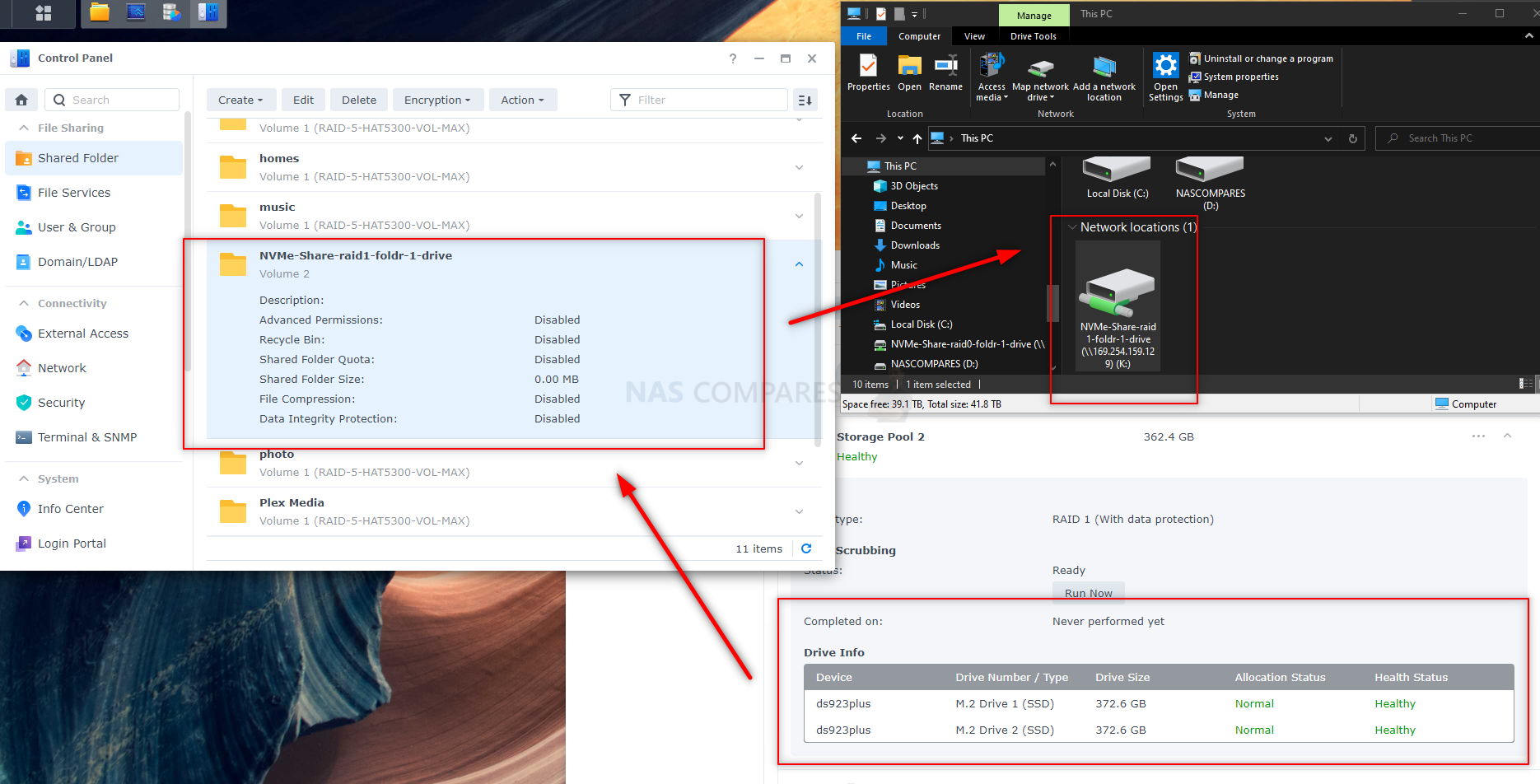
Atto Disk Benchmark, 2x SNV3400-400G M.2 NVMe SSD RAID 1 Storage Pool Tests
Atto Disk Benchmark tests first and although we saw a small improvement over the SINGLE in test #1, they were nowhere near what we saw from the RAID 0 results (unsurprisingly):
64MB File Size
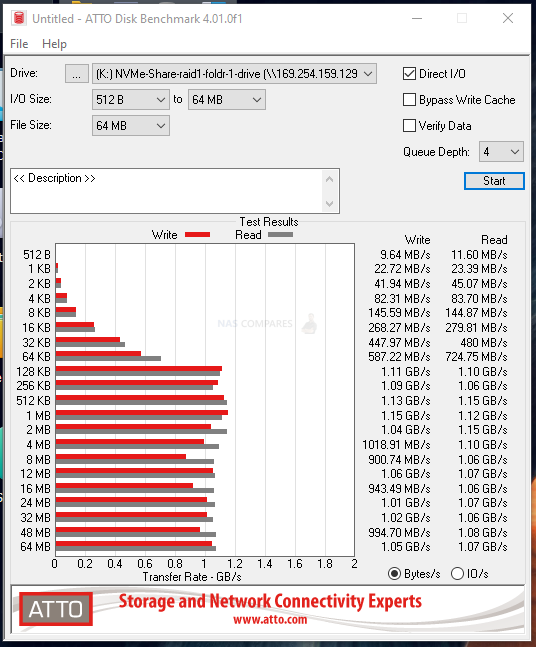 |
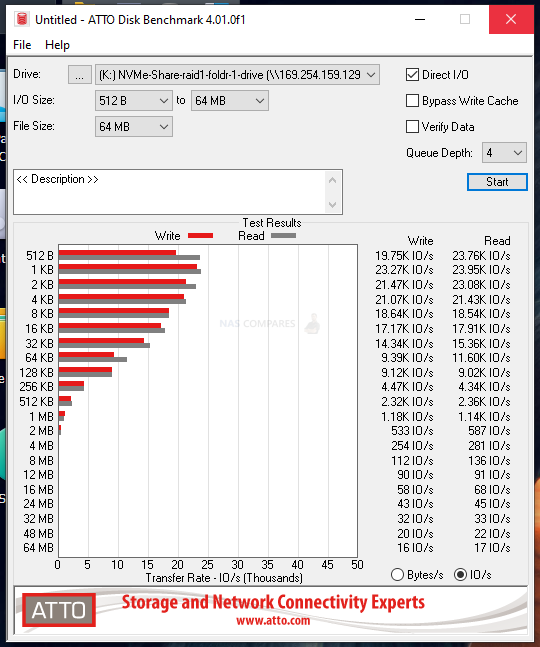 |
256MB File Size
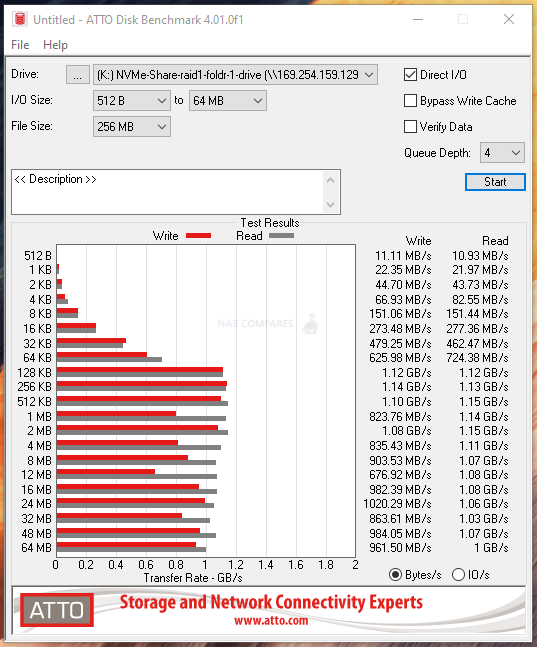 |
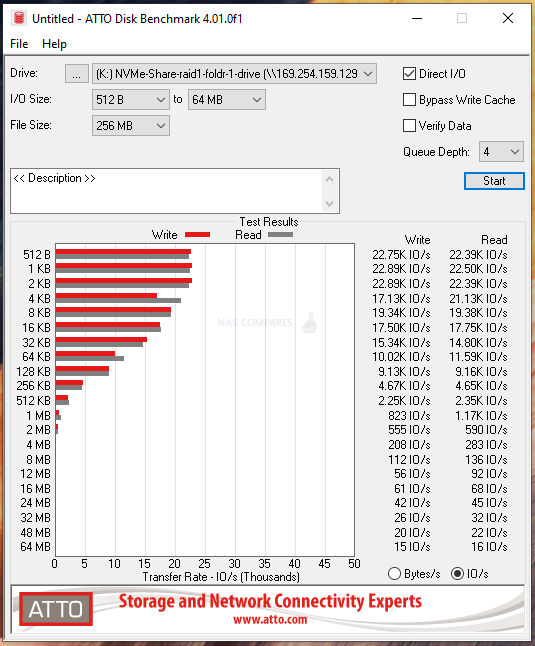 |
1GB File Size
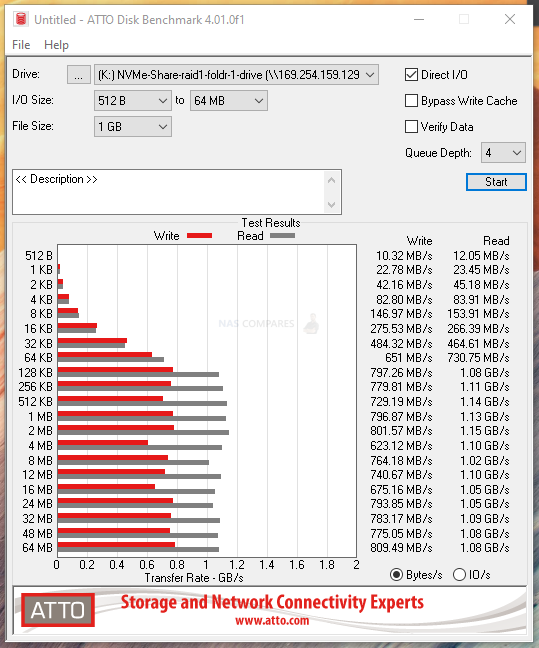 |
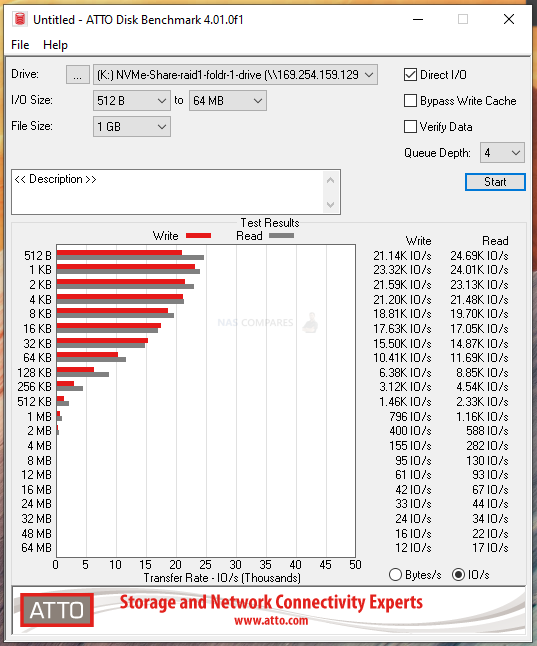 |
4GB File Size
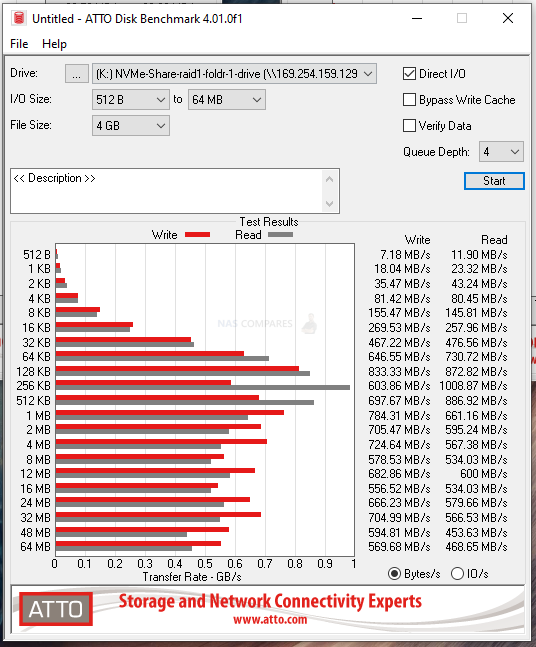 |
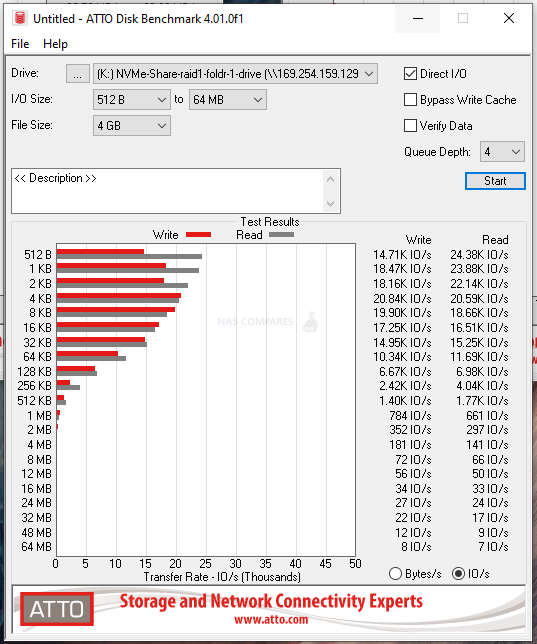 |
16GB File Size
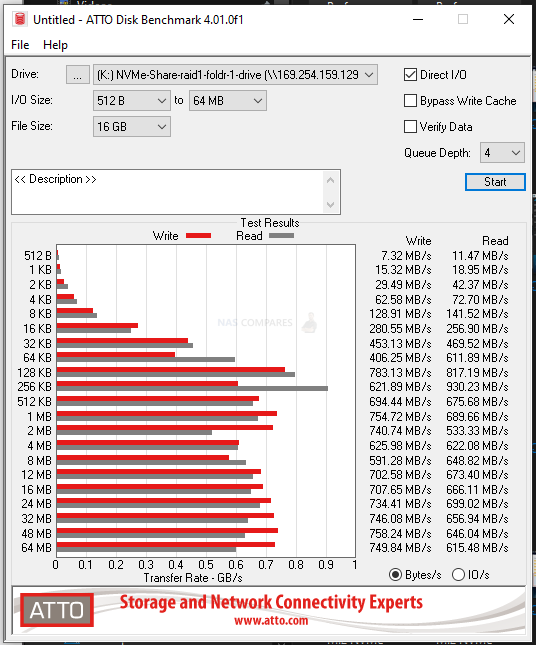 |
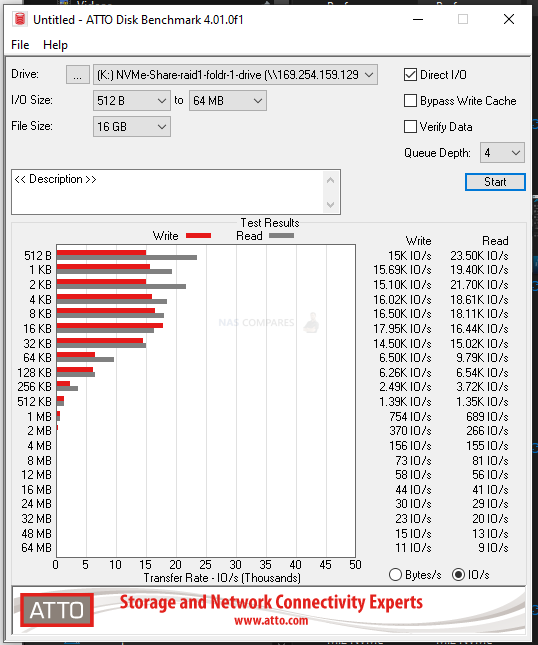 |
Overall, the RAID 1 vs SINGLE M.2 NVMe SSD tests in ATTO on these DS923+ mounted M.2 NVMes resulted in an increase of around 180-220MB/s on the file tests (average).
AJA Speed Test 1080i, 2x SNV3400-400G M.2 NVMe SSD RAID 1 Storage Pool Tests
AJA tests up next and their results were surprisingly low, in some cases under the SINGLE tests. Now, how much of this was down to the RAID 1 handling overworking the system compared with both the straightforward SINGLE and accessible RAID 0. Indeed, there may have been other factors in the test that need investigating (system access? Other Synology DSM services that taxed the system that were not disabled/deactivated? Perhaps a HDD-linked service that resulted in a bottleneck of throughput that is visible on the AJA performance graph). I intend to revisit these tests at a later date and update this article if the results are better on a 2nd test (unfortunately the test setup of DS923+ and drives is unavailable), but for now, here are the results:
256MB File Size*
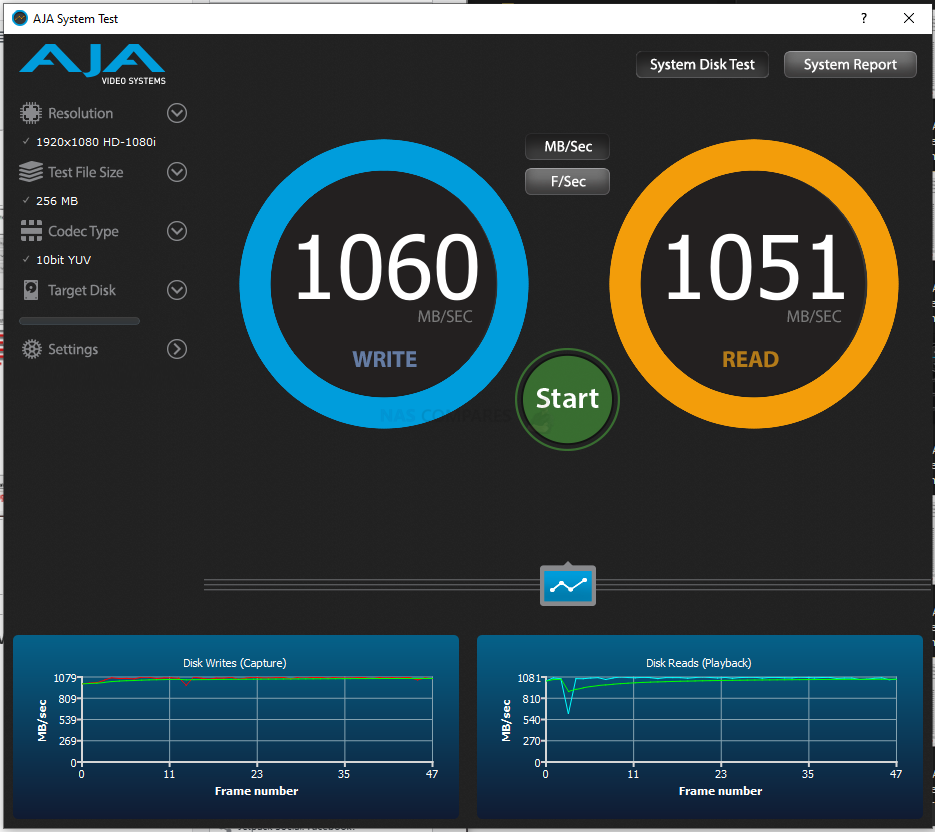
1GB File Size*
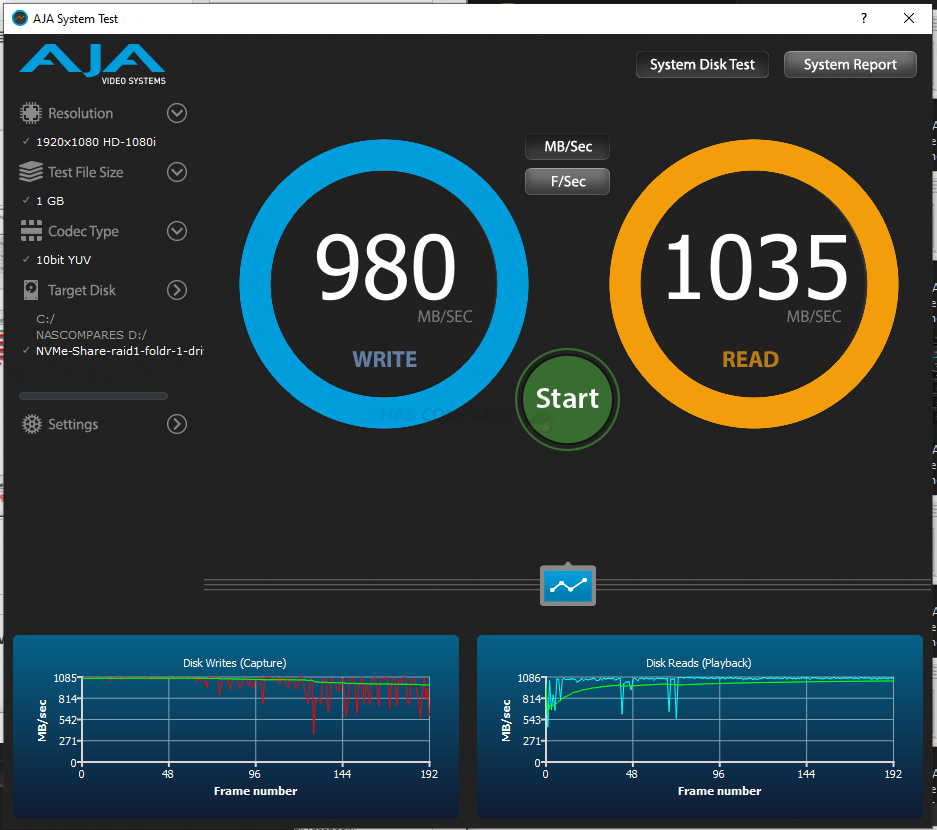
4GB File Size
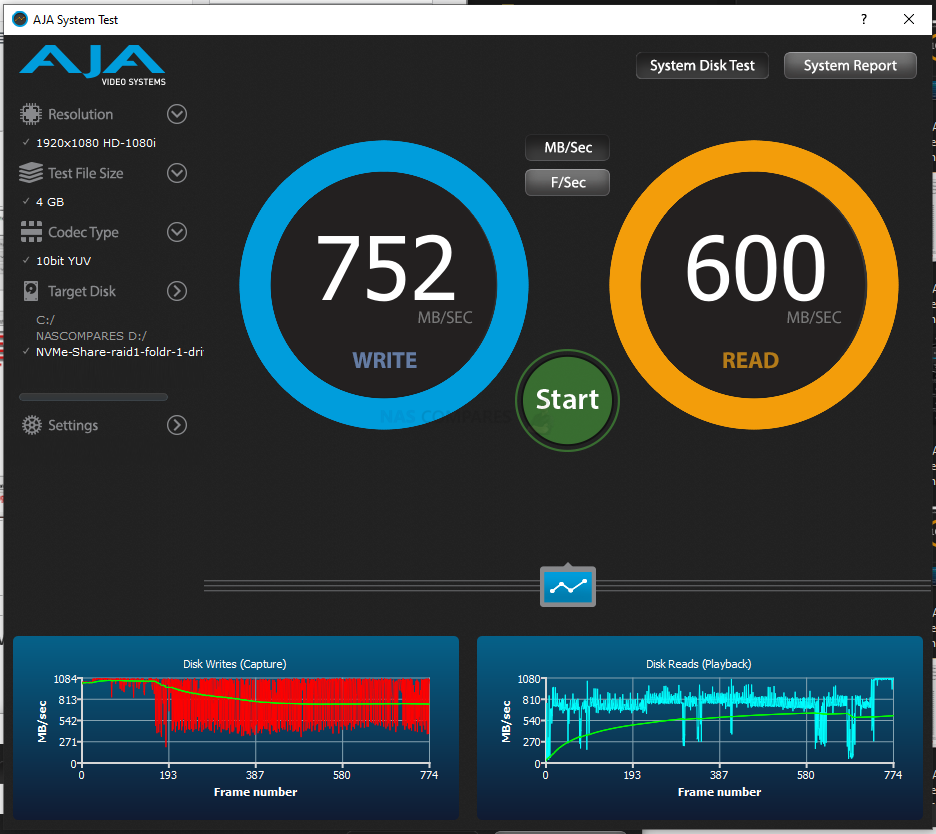
16GB File Size
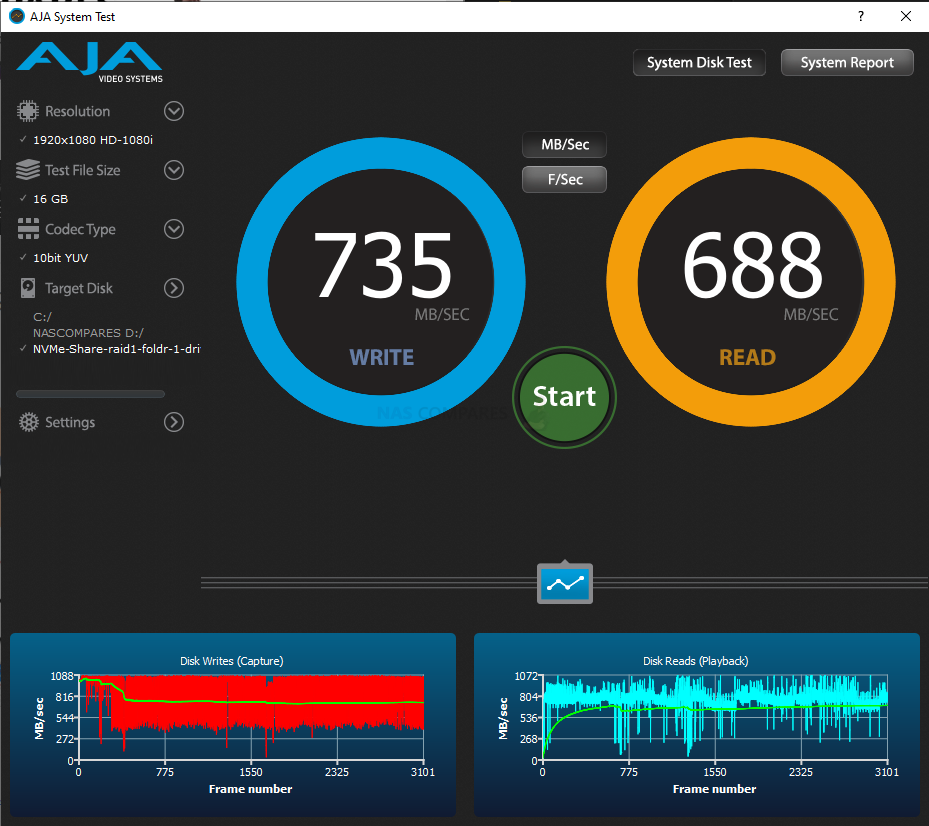
*I am suspicious of this test results and will be returning/revisiting these in this setup at a later date to confirm/update them.
Black Magic Speed Test, 2x SNV3400-400G M.2 NVMe SSD RAID 1 Storage Pool Tests
Finally, we have Black Magic for the RAID 0 M.2 NVMe SSD Performance tests and, although they were mostly good, the results were still dwarfed by the RAID 0 tests.
1GB File Size
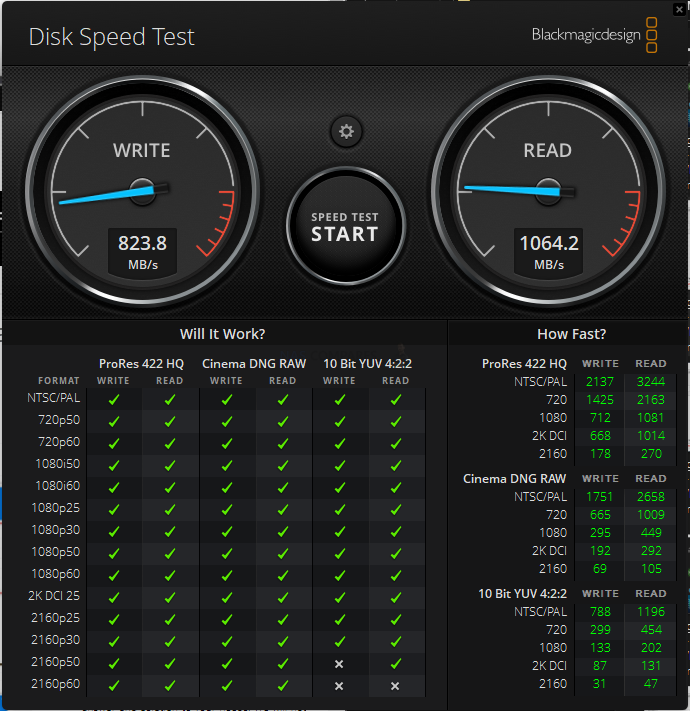
3GB File Size
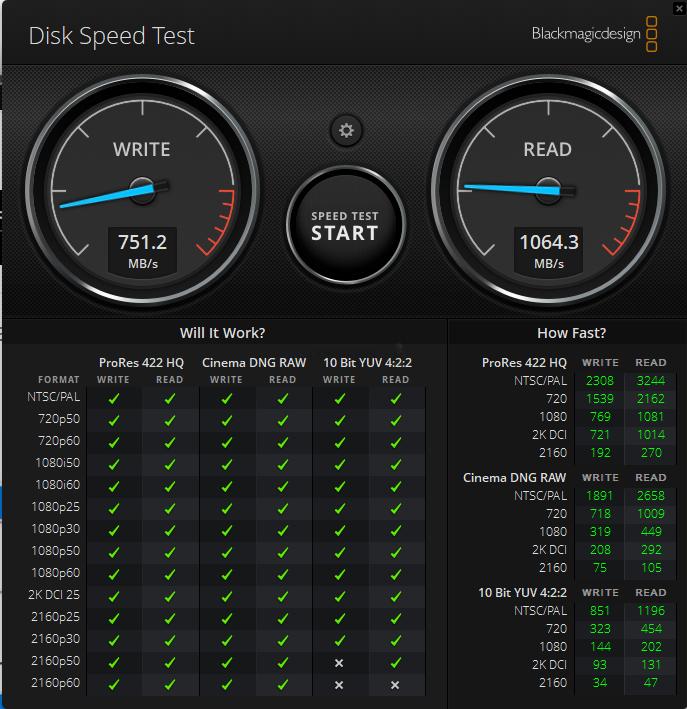
5GB File Size
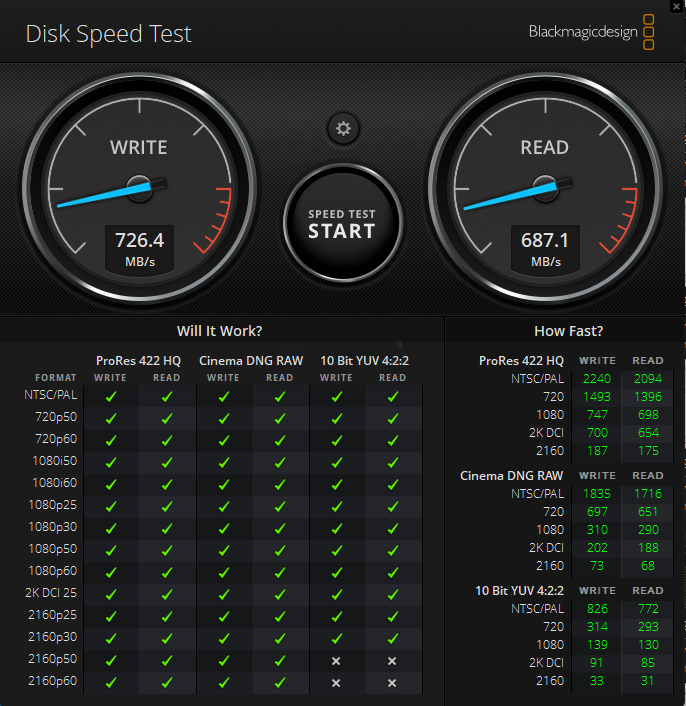
So, better results in RAID 1 than SINGLE (again, marginally), but RAID 0 still continues to be the big performer overall. Let’s conclude.
10GbE & M.2 NVMe SSD Storage Pools on the Synology DS923+ NAS – Conclusion
I would say that a RAID 1 test, once you factor in the cost of the Synology SNV3400-400GB SSDs vs buying a SATA drive that these M.2 NVMes can sync with sync/schedule within the background, is not worth using in this setup. The Performance of the RAID 0 on the DS923+ NVMe SSD Storage Pool was just so much better! Using the Faster area of storage on for video editing (when BOTH the Read and Write are important) as a scratch/editing disk, whilst letting the NAS coordinate with a slower but more cost-effective area of HDD RAID storage in the background makes alot more sense. Generally, I would NEVER recommend RAID 0 for anything in terms of meaningful storage as the lack of redundancy alone is a HUGE red signal, but as long as you have created a good sync in conjunction with it (as well as throwing in a layer of backup of course – remember, redundancy and backup are NOT the same thing!), it is going to give you the best results here in terms of external performance. Of course, as Synology play with this feature in future, perhaps enabling DSM booting from the M.2 NVMes, using the faster storage areas for apps and/or accessible storage in VMs and ABB, RAID 1 on these bays will lively be the smarter long term move. But right now, as these bays on the DS923+ appear to be capped AND compatibility (at least a the time of writing) is incredibly limited to lower speed drives than those available across the market, I would maybe recommend holding out on this feature until it gets a little more support and development. It is GREAT that M.2 NVMe SSD storage pools ar starting to become available to Synology NAS systems, but the way in which it is being rolled out is rather perplexing!
Can You Boot Synology DSM from the M.2 NVMe SSDs?
Unfortunately, at the time of writing and testing, you cannot use the M.2 NVMe SSD Bays on the DS923+ NAS as a boot drive for DSM. To clarify, I booted the device with NO SATA HDD/SSDs and JUST the 2x M.2 NVMe SSDs inside (so the system was in initialization mode). The DS923+ did not recognize the M.2 NVMe SSD drives as usable system media for the DSM OS. You are greeted with the image below:
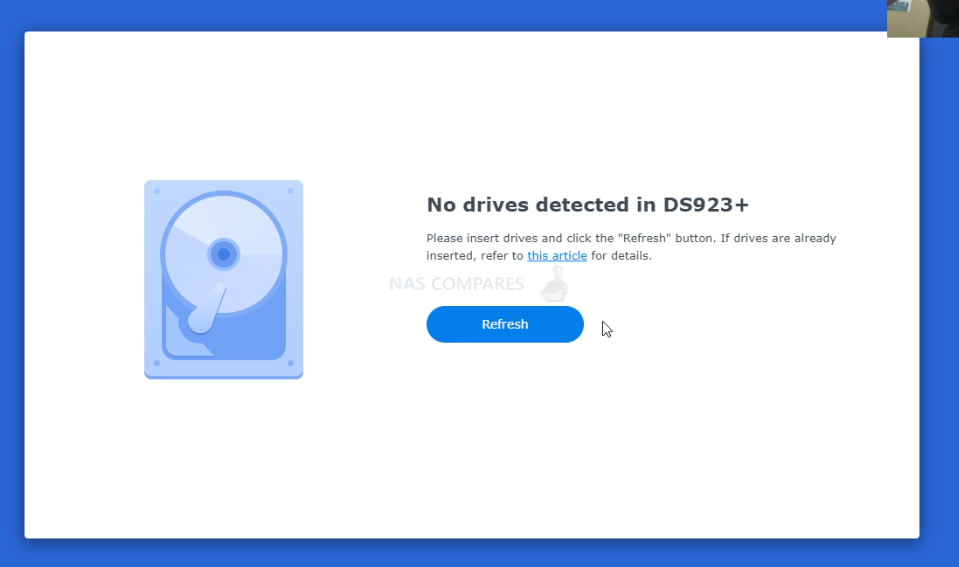
Perhaps this will be changed later on as the M.2 NVMe SSD Storage Pool utilization improves, but as it stands right now, you cannot use the NVMe drives for the system OS (but you CAN create Storage Pools and Volumes that you can then use within existing applications as sources, such as the Virtual Machine Manager and Active Backup.
Synology DS923+ NAS Review – Quick Conclusion
Synology has clearly made something of a gamble in the release of the Synology DS923+ NAS. There is no avoiding that making the switch from the Intel Celeron that has historically been the build choice of this product family and opting for the AMD Emb.Ryzen has ruffled some feathers! On the face of it, the R1600 here has a heck of alot of going for it over the previous generation! Higher clock speed, greater PCIe Gen 3 Support throughout, that 4-32GB of DDR4 memory in such a compact system and just generally giving you a lot more horsepower to play with, as well as better bandwidth potential inside and out! But at what cost? The 1GbE standard connectivity in the base model leaves alot to be desired, the proprietary 10Gb upgrade (though incredibly handy) limits the upgradability a tad and the lack of an integrated graphics processor is likely going to result in many long-term Synology advocates to skip this generation. Synology Diskstation Manager (DSM 7.1 at the time of writing) still continues to impress and although the brand still continues to heavily push their 1st party priorities, they have left a little more wriggle room in DSM 7.1 than DSM 7 before it in terms of media compatibility. In terms of design, I cannot fault Synology on this as the DS923+ chassis still arrives as one of the best-looking and still exceptionally well-structured devices at this physical scale and storage level. As always, a Synology NAS is more about the software than the hardware (and the DS923+ delivers in spades on the software side!) and with DSM 7.2 around the corner improving things. Just always keep in mind that the Synology DS923+ NAS is a system that arrives with the slight emphasis on having to do many things ‘their way’. If you are less technically versed, then you will definitely appreciate this level of user-friendly design and assistance, but more technically minded admins’ main strain a pinch! In short, the DS923+ IS a good NAS drive, but its focus has certainly ebbed more towards the business user this generation than the home.
| Where to Buy a Product | |||
|
|
    
|

|
VISIT RETAILER ➤ |
 |
    
|

|
VISIT RETAILER ➤ |
 |
    
|

|
VISIT RETAILER ➤ |
 |
    
|

|
VISIT RETAILER ➤ |
Need More Help Choosing the right NAS?
Choosing the right data storage solution for your needs can be very intimidating and it’s never too late to ask for help. With options ranging from NAS to DAS, Thunderbolt to SAS and connecting everything up so you can access all your lovely data at the touch of a button can be a lot simpler than you think. If you want some tips, guidance or help with everything from compatibility to suitability of a solution for you, why not drop me a message below and I will get back to you as soon as possible with what you should go for, its suitability and the best place to get it. This service is designed without profit in mind and in order to help you with your data storage needs, so I will try to answer your questions as soon as possible. We pool the comments on this article and the videos that are featured in it to keep all the relevant comments in one place, so take a look and see if your POV is the same as everyone else’s.
📧 SUBSCRIBE TO OUR NEWSLETTER 🔔
🔒 Join Inner Circle
Get an alert every time something gets added to this specific article!
This description contains links to Amazon. These links will take you to some of the products mentioned in today's content. As an Amazon Associate, I earn from qualifying purchases. Visit the NASCompares Deal Finder to find the best place to buy this device in your region, based on Service, Support and Reputation - Just Search for your NAS Drive in the Box Below
Need Advice on Data Storage from an Expert?
Finally, for free advice about your setup, just leave a message in the comments below here at NASCompares.com and we will get back to you. Need Help?
Where possible (and where appropriate) please provide as much information about your requirements, as then I can arrange the best answer and solution to your needs. Do not worry about your e-mail address being required, it will NOT be used in a mailing list and will NOT be used in any way other than to respond to your enquiry.
Need Help?
Where possible (and where appropriate) please provide as much information about your requirements, as then I can arrange the best answer and solution to your needs. Do not worry about your e-mail address being required, it will NOT be used in a mailing list and will NOT be used in any way other than to respond to your enquiry.

|
 |
A Buyer's Guide to Travel Routers - GET IT RIGHT, FIRST TIME
Jonsbo N6 DIY NAS Case Review
The Best Bits (and Worst Bits) of NAS of 2025!
Minisforum MS-02 Ultra Review
Minisforum N5 NAS, 6 Months Later - Better, Worse, the Same?
Beelink ME Pro NAS Revealed
Access content via Patreon or KO-FI
Discover more from NAS Compares
Subscribe to get the latest posts sent to your email.


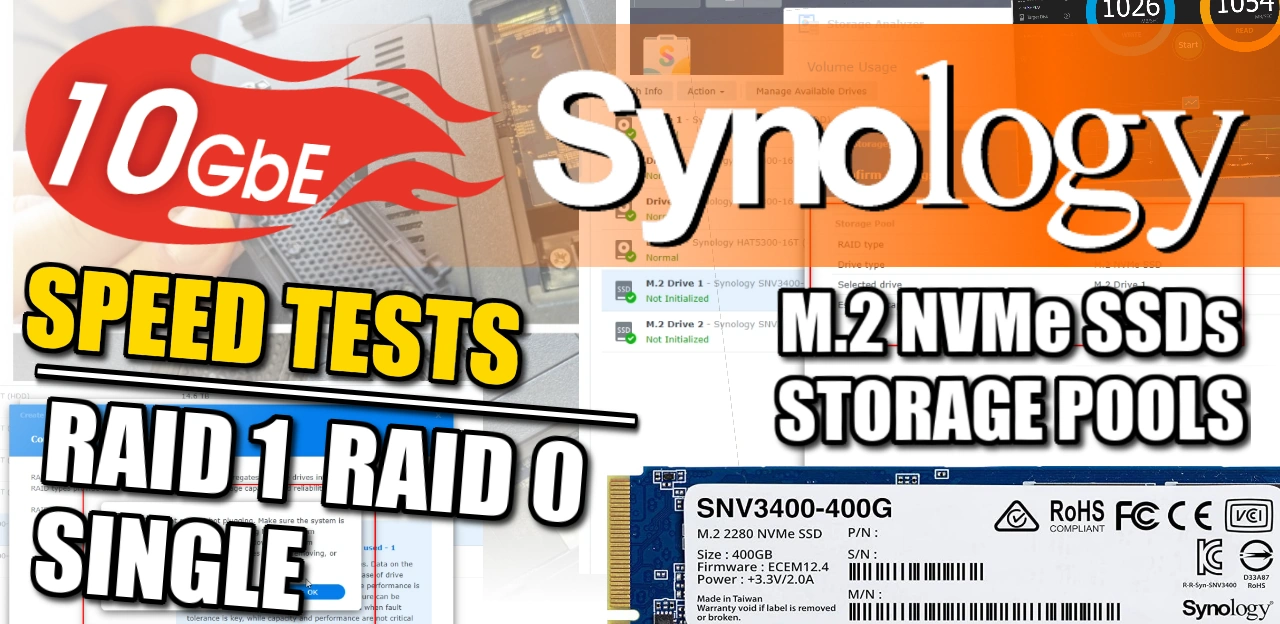
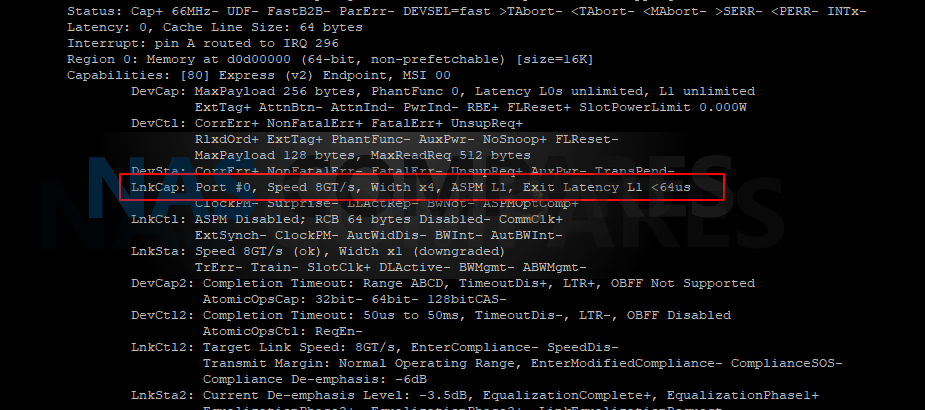
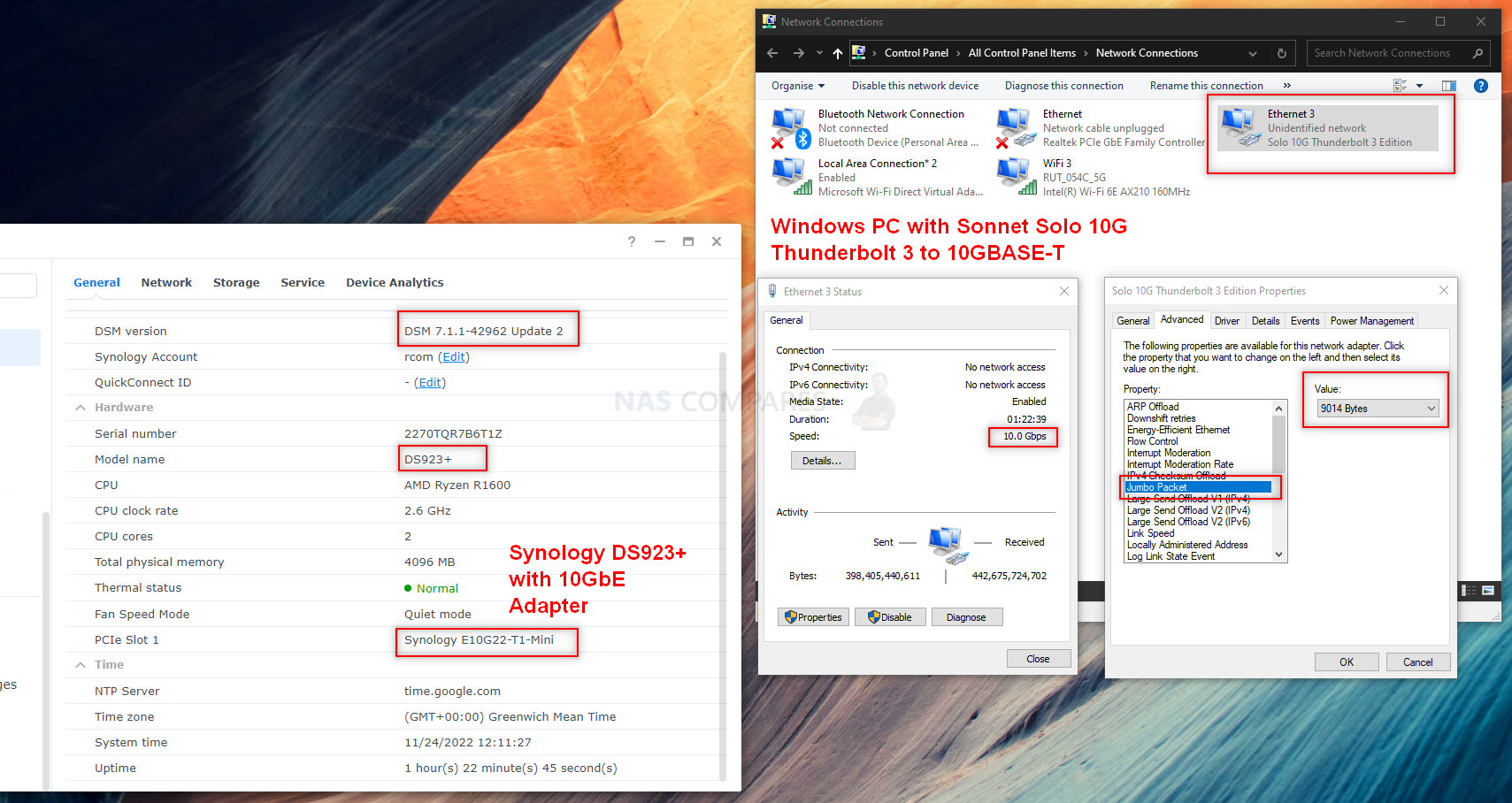
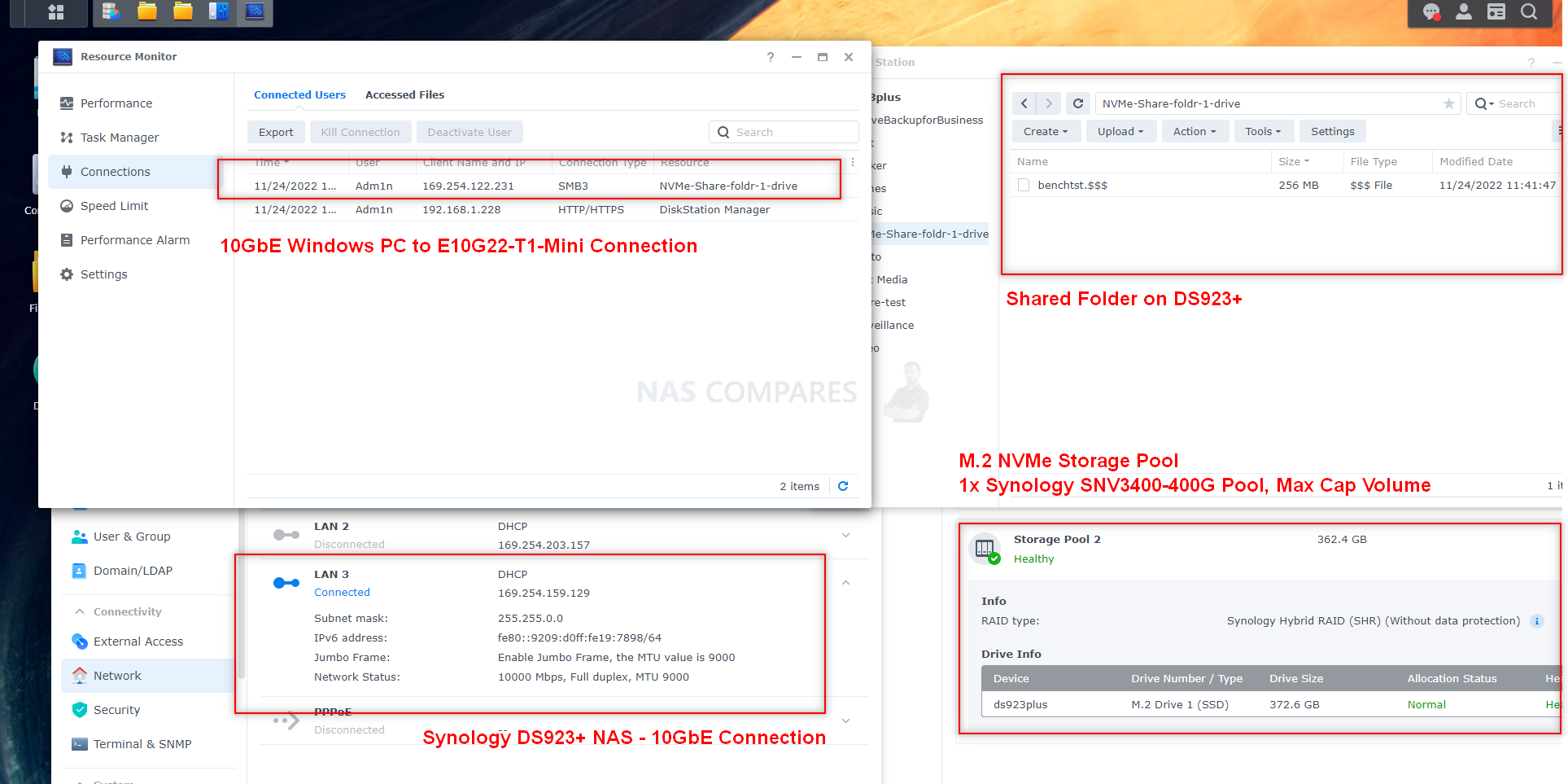




thanks, this saved me from buying 2 nvme ssds for the 1821+ as teir speed will be slower as raid 0, than 8 hdd in a raid6 (just read/write huge files)
surely i only would have used ssd with a script making non synology useable at all)
REPLY ON YOUTUBE
2 years later Synology still not supporting other NVMes
REPLY ON YOUTUBE
The 3.0×1 speed is likely a hardware limit due to the way Synology designed the pcie lanes on the board. I am mostly disapointed in their clearly artificial software hobbling of 3rd party drives.
The R1600 cpu has PCIe 3.0 x 8, PCIe Bandwidth: 7.9 GB/s,
8 lanes is used up pretty fast even with one lane per drive plus one for each external port… and any pcie expansion chips will funnel several devices into fewer lanes anyway (Not a bottleneck for slower or sporadically accessed devices, but lane layout is important.)
REPLY ON YOUTUBE
One year later – any change on this policy from synology?
REPLY ON YOUTUBE
Hey, I’m planning a couple of Windows VMs on a 1821+ to manage the remote backups and my plex server. Is it better to use the NVMe as storage pool for the VMs or as a cache for the main big storage pools?
REPLY ON YOUTUBE
Thank you. That was very interesting ????.
REPLY ON YOUTUBE
The sad part is that this is a simple fix, skip the product SKU check. Surely this must be an easy hack to remedy, if you know what file to edit??
REPLY ON YOUTUBE
Installing plex server or VMs on m.2 storege pool, can it be done? Or on the m.2 volume you can only hold files and folders
REPLY ON YOUTUBE
I have a nvme ssd pool on my 920+ (WD red) where I only install software and VM, after latest restart I get an error “not supported by current DSM version”.
I don’t even know how to fix this now. Any suggestion?
REPLY ON YOUTUBE
What would I need ssd pools other than file editing on pc?
REPLY ON YOUTUBE
Thanks for this video as I truly believe it is still relevant (04/13/2023) and the confusion is yet very real, at least for me as a DS1821+ user.
REPLY ON YOUTUBE
Hmmmmmm …… request an update on this subject;
The DS920+ has just been discontinued probably to steer buyers to the lackluster DS923+ (ex: @7:40 NVMe SSD HW is PCIe gen3x4 but is SW capped at PCIe gen3x1 ;).
REPLY ON YOUTUBE
I have a ds1612+ that has 2 pools – 3x8gb hdd shr for bulk storage and 2x1gb ssd shr mainly for VM images and other speed sensitive stuff ( home directories etc. And 2x500gb nvme for cache. As an experement, I created a storage pool on the nvme drives (using ssh and shell commands, unsupported) And it all worked and was as fast as I hoped.
BUT – the nvme drives ran very hot (50C-60C and higher), and on at least two occasions (copying 100Gb+ from ssd to nvme) the system shut itself down due to heat.
If I had thought about it in advance, I could have turned up the fans to full, but that’s hindsight. And that was too noisy for everyday use, for me.
So it looks as if the suggested reason synonlogy dont support this yet because of heat issues , may have some truth to it. Note this was the only issue I had, and it was gratifyingly fast.
I’ve now reverted to ssd for fast storage, hdd for bulk, with nvme cache for both ssd and hdd pools. As well as back to a supported configuration, It just feels safer.
REPLY ON YOUTUBE
@NASCompares – what options exist in the NAS space for SSD based systems?
REPLY ON YOUTUBE
THANK you for this review!! I had ordered a DS923+ because of the NVME storage and cancelled the order – saving me a lot of missed expectations.
REPLY ON YOUTUBE
I think Sinologist greed has gotten them in trouble. I will not buy a BAS system where I can’t use standard memory brands. Goodby Synology.
REPLY ON YOUTUBE
Is there such a thing as a simple one or two slot SSD nas ? Which do you suggest?
REPLY ON YOUTUBE
I think they have limited the SSD Pools to the 923+ in a desperate attempt to save the product, otherwise there would be literally no reason to upgrade from a 918+/920+. Also I think support for the 918+/920+ will last until the successor of the 923+ will be released, which probably will be Intel based again, so also longer support (as was mentioned as a reason to buy the 923+ in a previous video) is really no reason to upgrade to the 923+.
REPLY ON YOUTUBE
What could be a technical reason for the link cap? Cannibalising the rack stations?
REPLY ON YOUTUBE
I have had several synologys since 2012. Love them. Currently have a 1520+ which is great. But the way synology is going with the new dual core processors and now this… I’m building my own unraid nas and let’s the 1520+ be a secondary for the next many years. Synology is on the way downhill…
REPLY ON YOUTUBE
I found out that NVMe has to be from Synology, when I already ordered some WD Red NVMe. So I manually created a Volume with them via terminal and I really hope I won’t regret it later. Do others have experience with manually created RAID 1 NVMes on Synology?
REPLY ON YOUTUBE
I just have to say: What the hell did you expect? Synology have been throwing their draconian BS left and right for a long time now, and you wait until now to be really genuinely outraged? About this? This is bloody peanuts compared to the other shit they’ve pulled in recent history. Still, thank you for finally taking a concrete and forceful stance on something like this. It was about time.
REPLY ON YOUTUBE
Mabie try being awake when you film a video
REPLY ON YOUTUBE
Having now watched this, will abandon Synology thoughts for the moment. Maybe QNAP or stick with TrueNas.
REPLY ON YOUTUBE
Argh! ???? So frustrating! Not withstanding I already bought a 2TB Samsung M.2 NVMe for my DS1821+ for a storage pool, what seems to be neglected is that folks like me who took up a bay for a 2TB SSD for VM’s could gain that bay back for a 14, 16, 18TB or more for much more increased storage availability on your NAS. This capability approach better get corrected or many will be persuaded to look elsewhere.
I get forcing enterprise users to buy Synology drives, but forcing prosumer devices to do so will be a self inflicted wound. Typical home users and even small businesses do not have the budgets to support that, especially in this economy and Synology should know better.
Synology’s claim to fame is giving users features otherwise unavailable with other brands. If they continue to limit adding capabilities others have had for years, it will be a very bad mistake. I’d say I’m slightly on the other side of annoyed compared to Rob and Eddie. ????
REPLY ON YOUTUBE
I received my DS920+ today. I have no need for NVME storage pools. I’ll be using the DS920+ for Audio, Video and Backup. 12/05/2022 2232
REPLY ON YOUTUBE
I totally agree with Robbie. It feels half baked. I’d love to see DSM running off the SSDs! I’d buy that for a dollar!
REPLY ON YOUTUBE
I totally agree with Robbie. It feels half baked. I’d love to see DSM running off the SSDs! I’d buy that for a dollar!
REPLY ON YOUTUBE
I’m just setting up my new 923+
For me the NVMe wasn’t ever about storage pools, I’m more interested in them for cache and not for speed but HDD drive longevity. Also ECC RAM support is MAJOR for me. I’m still amazed that all RAM in 2022 isn’t ECC. There’s good reason servers generally use ECC ram. Sure it can be “slower” but RAM is so damn fast these days that’s a negligible downside in real terms.
REPLY ON YOUTUBE
I’m just setting up my new 923+
For me the NVMe wasn’t ever about storage pools, I’m more interested in them for cache and not for speed but HDD drive longevity. Also ECC RAM support is MAJOR for me. I’m still amazed that all RAM in 2022 isn’t ECC. There’s good reason servers generally use ECC ram. Sure it can be “slower” but RAM is so damn fast these days that’s a negligible downside in real terms.
REPLY ON YOUTUBE
Have you ever worked in hardware development and testing? If you did, you would not speak like 2nd grade brat.
REPLY ON YOUTUBE
Aka planned-obsolescence, crippling-great hw, etc
Soooooooo now it’s DS223+ or Bust (fingers-crossed 😉
REPLY ON YOUTUBE
Synology missing the point about a provider role is, excellent video
REPLY ON YOUTUBE
So I ordered a ds1621+ for cyber Monday. When i added the 10gb card I noticed the m.2 daughter board was only a pcie 1x connector for both ssd.
If they used a non spec connector with their own pin out they couldn’t possibly have more then 2 lanes per ssd… I’m guessing one lane per drive.
REPLY ON YOUTUBE
Thank you for this awesome update. I own the DS1522+ and I’ve held out on purchasing SSD’s in order to see which direction Synology goes in.
REPLY ON YOUTUBE
The announcement does seem bizarre for only one product, but their requirement for their M.2 ssd’s as a requirement is not. Synology is going more this route of locking down supported storage. As a result I’m going with QNAP as my new 8 bay. I have a wonderful DS1520+ which has been bulletproof but QNAP supports many more vendors for both HDD’s and SSD’s. They support ssd storage pools now.
REPLY ON YOUTUBE
You have yourself a bloody great Christmas too! ????????????
REPLY ON YOUTUBE
For me, as my experience with IT goes, I had decided early-on that I would track stable branch of software and not at all beta. Seems to me maybe they are using consumers for beta testing? Although I’ve done testing in software, I prefer to be paid for my testing – unless it is just a cool and wanted feature. I do leave the door open for that instance.
REPLY ON YOUTUBE
For me it’s totally true that M2 it’s a killer app type feature because I was doubting between ds920+ with Jellyfin transcoding or ds923+ with M2 for my apps/dockers. finally I get the ds920+ because it’s also a joke the Synology compatilibity for M2 as storage.
REPLY ON YOUTUBE
Typical Synology move to be honest. I love their NASs but they are just so frustrating when they keep shooting themselves in the foot.
Have to agree with all your points, constantly holding their hardware back with bizarre software decisions.
REPLY ON YOUTUBE
Amateur hour at Synology releasing the SSD storage pool feature as it is. Why cant I use my trusty Samsung Pro NVMe? And please put NVMe in Rackstation models please. I won’t buy a Synology NAS until this is addressed. Also ditch the 1Gbit and add WOL support to the 10Gbit card
REPLY ON YOUTUBE
I have bad memories of the NVMe cache launch with the 2018 models, back then Synology was on DSM6 and NVMe cache did not add the improvements people expected. Everyone said: “Don’t bother, waste of time, your data is at risk on cache during a power outage, worthless!” But then DSM7 came out and NVMe cache finally worked, it took everyone months to re-review it and finally change the public opinion: “Synology NVMe cache is actually pretty good.” It feels like we’re in that same situation, where the NVMe storage pool hardware is there, it could do it, but DSM isn’t ready for it, and Synology do not have great M.2 drive options if we are forced to use their SSDs.
REPLY ON YOUTUBE
Highlighting the negatives is consumer centric and that’s the way it should be. I want to upgrade from a ds216+II but synology just can’t seem to find a way to take my money.
REPLY ON YOUTUBE
show me the data/results/statistics – not the talk 😉 thx, best
REPLY ON YOUTUBE
It hurts to wake up ????
REPLY ON YOUTUBE
*Note* – Apologies for the clickbaity title. I ‘ummed and ‘ahhed for about an hour on the title, as this is more about my own POV based on M.2 NVMe SSD support. Plus, this is a feature that will likely improve and increase in its use over time. So I will delete this video when it becomes irrelevant. Have a great week!
REPLY ON YOUTUBE
So, not possible on ds920+?
REPLY ON YOUTUBE
How much impact would M.2 NVME Gen4’s make? I’m thinking about either a QNAP TVS-h474M.2 (2 x M.2 2280 PCIe Gen3 x2 slots) or TVS-h674 (2 M.2 2280 PCIe Gen4 x4 slots)
REPLY ON YOUTUBE
is it possible to use the m.2s as a art of ram to bring in the data via 10gb and then atomaticly mirrow this data to 10tb internally to wd reds 10tb?,i only thinking????
REPLY ON YOUTUBE